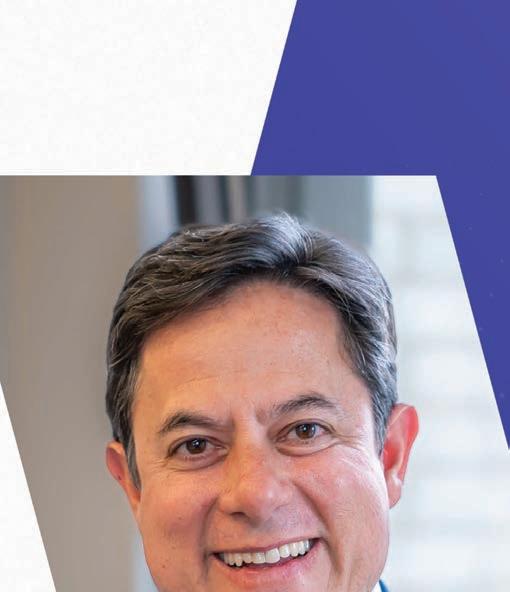







Crain’s celebrates the young rising stars who are bringing fresh energy to real estate, health care, technology, politics, sports and entertainment
Page 11















Crain’s celebrates the young rising stars who are bringing fresh energy to real estate, health care, technology, politics, sports and entertainment
Page 11






The stunning reversal comes just weeks from the planned June 30 launch date
By Caroline SpivackGov. Kathy Hochul has indenitely postponed the launch of the MTA’s long-anticipated congestion pricing tolling program, blaming economic concerns, in a stunning shift that sent shockwaves through the city.
e governor is delaying the tolls just weeks before congestion pricing’s planned June 30 launch date.
◗ Hochul was ‘looking for cover.’ P. 2
◗ Borough president: Dems risk defeat in congestion pricing retreat. P. 2
◗ Governor’s stance changes quickly. P. 23
“After careful consideration, I have come to the difficult decision that implementing the planned congestion pricing system risked too many unintended consequences for New Yorkers at this time,” Hochul said in a recorded message June 5. “For that reason, I have directed the MTA to indefinitely
See POSTPONE on Page 23

A


Hochul was ‘looking for cover’
despite publicly praising the program, insiders sayNick Garber
Long before Gov. Kathy Hochul stunned New York on June 5 by shelving the congestion pricing program at the last minute, she had been concerned about the political fallout from implementing the tolls.
“ e governor’s been very worried about this for months,” said one person who has spoken with Hochul directly. “She was looking for cover.”
Few political insiders put full stock in the stated reason Hochul o ered on June 5 for delaying the
with White House o cials, including President Joe Biden, about postponing the plan to charge most drivers $15 to enter Manhattan below 60th Street, according to a federal government o cial who requested anonymity to discuss the private conversations. But state lawmakers, who passed the law that created congestion pricing, were blindsided by the news.
“I’m heartsick,” said Manhattan state Sen. Brad Hoylman-Sigal, who supports the tolls to ease trafc and fund critical transit work.
“It seems like a decade lost, not to mention the enormous cost to public health, mass transit, a sustainable economy and the environment.”
“It seems like a decade lost, not to mention the enormous cost to public health, mass transit, a sustainable economy and the environment.”
Brad Hoylman-Sigal, state senator, Manhattan
toll inde nitely: that she wanted to avoid imposing new costs on working-class people or jeopardize Midtown Manhattan’s pandemic recovery. Instead, most pointed to recent polls that showed nearly two-thirds of New York voters oppose congestion pricing, posing a potential hazard for the ve Democrats running in swing-district U.S. House races in suburbs near the city.
Hochul spoke in recent days

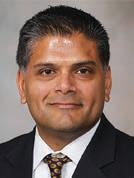
Join Crain’s and Healthcare Financial Management Association, Metro NY Chapter (HFMA) for a day of live interviews and panels with the city’s top health care leaders and decision makers. We’ll engage in lively discussions on a wide range of topics, including regulatory changes coming to Medicaid and Medicare Advantage, the current state of the pharmacy bene t manager industry and how technology is reshaping the health ecosystem in the city
DETAILS
House minority leader Hakeem Jeffries of Brooklyn, whose speakership rides on the swing House races, denied playing any role in Hochul’s abrupt reversal. A Je ries spokesman, Andy Eichar, said that Je ries “has maintained neutrality” on congestion pricing — but also o ered ready praise for Hochul’s choice.
“To the extent immediate implementation of congestion pricing is being reconsidered, Leader Je ries supports a temporary pause of limited duration to better understand the nancial impact on working-class New Yorkers
who have confronted a challenging in ationary environment as a result of the pandemic,” Eichar said.
Still, in the absence of immediate evidence, some local o cials turned their suspicions toward Washington. William Barclay, the state Assembly’s Republican leader, praised Hochul’s decision in a statement — but called it “a calculated maneuver to avoid a political disaster.”
“ is sudden heelturn is because the political rami cations of congestion pricing would have hurt Democrats in upcoming congressional races,” Barclay said.

Although Hochul has publicly praised congestion pricing for years, she has maintained a private distaste for some of its ramications. Rumors that Hochul might try to delay the implementation were ying during the waning days of state budget negotiations this spring, one lawmaker said.
Huge questions remained unanswered by June 5 — starting with whether state lawmakers have any interest in Hochul’s new
proposal to raise taxes on New York City businesses to cover the $1 billion annual hole that was supposed to be lled by congestion pricing revenue. Legislative leaders have not publicly addressed the plan.
Local o cials continued to puzzle over why Hochul waited until now to act — 25 days before the tolls were supposed to take e ect. Hochul o ered no clarity about that timing during her pre-recorded speech, pointing only to long-running issues like in ation and the Covid-19 pandemic. It remains to be seen whether
state Democrats will see a boost in November by punting the unpopular program. But Hochul’s decision drew unusually strong criticism from establishment groups that typically ally with her, like the Regional Plan Association, the Partnership for New York City and the New York Building Congress.
“We are living in a bad episode of ‘ e Twilight Zone,’ ” said Carlo Scissura, the NYBC’s president and CEO.
Democratic lawmakers risk defeat in November’s election now that Gov. Kathy Hochul has backed down from implementing congestion pricing, said Brooklyn Borough President Antonio Reynoso.
“ is compromising is why we continue to lose,” Reynoso said June 5 at a Crain’s Power Breakfast with all ve borough presidents on stage. e event took place a few hours before Hochul said she would suspend congestion pricing inde nitely because of the high cost of living. “I think, politically, it’s a big mistake,” Reynoso said.
Capitulating on issues such as congestion pricing at this late hour could discourage progressives from voting across the city, Reynoso said, and cost Brooklyn Rep. Hakeem Je ries a shot as speaker of the U.S. House of Representatives. Reynoso reminded the audience at the New York Athletic Club that the governor’s plan to replace congestion pricing’s anticipated $1 billion in annual revenue with new taxes on business wouldn’t be popular, either.
“ en you guys will join me in

my ght” to deliver congestion pricing, he told the audience, “so that you don’t get taxed.”
All of the borough presidents support congestion pricing except for Staten Island’s Vito Fossella; his o ce has sued to block the program. Bronx Borough President Vanessa Gibson said after hearing complaints from residents and
drivers that she wasn’t surprised that Hochul would back down.
“Privately I was wondering if that was going to happen,” she said. “Maybe if there is a delay we can use that time to gure out a balance so that New Yorkers don’t feel the brunt of a nancial burden but rather see the positives that congestion pricing can bring.”
Manhattan’s Mark Levine said he worried a six-month delay would morph into six years and then go on inde nite pause. “We do need to get it done,” he said. Donovan Richards of Queens added, “I am a supporter of congestion pricing,” while Fossella said going back to the drawing board is “the right thing to do.”


The redevelopment will be the rst major overhaul of the transit hub in 73 years
e Port Authority of New York and New Jersey's $10 billion proposal to reimagine Midtown's notoriously dilapidated bus terminal calls for a beefed-up structure that would dwarf the current 73-year-old facility and include ground- oor retail space and a neighboring park.
Planning o cials last month presented an early look to the City Planning Commission on how the Port Authority aims to transform the 41st Street facility between Eighth and 10th avenues into a bright, modern travel hub.
“ is represents a once in a generation, really a once in a lifetime, opportunity to reinvent one of the major front doors of New York City,” said Ben Hu , a senior project manager at the Department of City Planning’s transportation policy and analytics division, who presented the plan and is among the army of city employees reviewing the Port Authority’s proposal. e design of the terminal has yet to be nalized or formally begin the city’s public review process.
To the west of the main terminal, on 40th Street between Ninth and 10th avenues, the Port Authority aims to construct a new facility where buses can be stored and can dwell ahead of accessing the gates where they pick up riders. Buses now have to wait and cause congestion on nearby streets.
Port o cials also want to cover existing tra c lanes on Dyer Avenue with a park. A helix-shaped ramp structure connecting Lincoln Tunnel to the bus terminal would make up the western most portion of the project, stretching the existing footprint of the site along 40th Street to 10th and 11th avenues.
e new ramps, park space and storage facility could be complete by 2028, while the main terminal building is expected to be complete by 2032.
Over the main terminal building along Eighth Avenue, the Port Authority is pinning its hopes on the recovery of Manhattan’s o ce market, with plans to allow developers (they’ve yet to be selected) to build two skyscrapers to help nance the project.
Revenue from a third o ce tower will also help support the project; that tower would be built on land bounded by West 30th and West 31st streets and ninth and 10th avenues near the Lincoln Tunnel.


e Port Authority and Mayor Eric Adams administration agreed to an arrangement in March that commits up to $2 billion in property tax revenue from the commercial towers to help nance the bus terminal’s redevelopment.
Port Authority spokesman Tom Topousis told Crain’s that it is “too early” in the development process to say whether the agency will issue a request for proposal and have devel-
opers selected prior to the start of construction on the main bus terminal. Topousis added that “depending on market conditions and other factors” the two o ce towers could move forward at the same time of construction on the main terminal or after its completion in the 2030s.
e Midtown transit hub's overhaul would be the rst wholesale redevelopment in the terminal's history and is intended to accommodate an anticipated swell of travelers in the coming decades.
e new main bus terminal will feature ve operational bus oors with greater space for buses to navigate, including 40 intercity bus gates.
◗ As many as 350 buses could be stored at the new facility — up from the current 50.
◗ e main terminal will include street-facing retail space.
e two proposed commercial towers over the main terminal building could rise as high as 1,344 feet and 926 feet, respectively.
◗ Roughly 3.5 acres of public green spaces would be created by decking over the currently below-street level Dyer Avenue cut and building open space atop.
On a typical weekday in 2019, the terminal served an estimated 260,000 passengers on 7,800 buses — roughly 23% of the trips traveling across the Hudson into or out of Manhattan’s core, according to Port Authority data. But port ocials project that gure could rise to 337,000 travelers per weekday by 2040, and people looking to swap their car trip for a bus ride due to congestion pricing could push that number higher.
e current bus terminal was not only designed for fewer travelers but small buses. Modern buses are typically 45 feet long and 102 inches wide, which can cause logjams and operational issues at the existing terminal. Serving bigger buses more e ciently means bigger buildings and structures will be needed at the bus terminal.
“ e current facility was designed for smaller buses,” stressed Hu . “With the ve operating levels, we have larger gates, more exible gates that will allow buses to come in and out quicker through the facility.”
e proposal still requires federal and city approvals.
The pair of buildings still sold for less than they likely would have before 2019’s rent reforms.
Some investors hoping to run a familiar playbook with rent-stabilized apartment buildings — raise rents to boost income when units become empty — have recently come up short.
Rules the state passed in 2019 to protect tenants against rent surges also made it harder for landlords to deregulate units, and banks have responded by limiting loans for multifamily deals, essentially locking up the market, developers say.
But the recent sale of two walk-ups on the Upper West Side suggests demand for rentals is far from dead. In May, Checo Acquisitions, a twoyear-old rm focused on local deals, snapped up a pair of buildings that contain some rent-regulated units, 472 and 474 Columbus Ave., for $14.5 million, with JPMorgan Chase providing $9.4 million in debt.
“Real estate markets move much more slowly than stock markets, and it took years for investors to understand the kinds of returns they could get,” said Aziz Syed, a Checo vice president. “But investors are starting to have an appetite again.”
e new market might also benet from sellers adjusting their expectations. Pre-2019, properties like the Columbus Avenue rentals, which have a total of 36 units, might have fetched $1,000 per square foot, but they sold for slightly less than half that in the deal with Checo, which is an investing arm of the Chehebars, one of the prominent Syrian Jewish real estate families of Brooklyn.
e seller, Bruce Haley, appears to have paid $91,000 for the addresses in 1979 and had no mortgage on the properties, records show, so even at a reduced rate the upside for some landlords appears considerable. Haley, a Florida resident, could not be reached by press time.
Checo may not have been swayed by curb appeal. Brick, prewar and at ve stories each, Nos. 472 and 474 are the kind of tenement-style buildings that pack neighborhoods from the Lower East Side to Harlem and hardly get a second glance. But they do o er a handful of retail spaces between them, all of which are occupied — one by yme & Tonic, a popular gluten-free restaurant. ough Covid did leave some hollowed-out storefronts on Columbus in its wake, Nos. 472 and 474 seem to have weathered the last few years well, undoubtedly a selling point, too.
But most critically, perhaps, the presence of rent-stabilized tenants who might stick around for decades (Checo would not say how many there are exactly) did not seem to faze a rm interested in long-term holds. “We love stabilized housing,” Syed said. “A ordable units are the backbone of the entire city.”
Considered among the city’s most genteel enclaves today, the Upper West Side was actually once considered rough, and perhaps no block was more checkered than West 84th between Columbus and Amsterdam avenues, as hard as it may be to believe today. The New York Times described the street in 1961 as teeming with “drunkeness,” “narcotics addiction” and “despair,” among other problems, on the occasion of a 400-person brawl. (But the “troubled” area actually stretched from West 79th to West 86th streets and from Central Park West to Riverside Drive, the article said.) The block’s fate was sealed by the early ’60s, however, when Mayor Robert Wagner condemned six buildings on West 84th and 15 structures on West 85th to create a massive L-shaped site for Public School 9, which opened in 1965 in a new blue-brick-lined home. Today called the Sarah Anderson School, the pre-kindergarten to fth grade-teaching institution, which has an enrollment of about 470, is considered one of Manhattan’s best. Niche, a school ranking service, gives it an A grade.
This 5-story, 24-unit building, along with the adjacent and slightly skinnier 472 Columbus, a 5-story, 12-unit offering, traded in May for about $15 million. The buyer was Checo Acquisitions, a two-year-old offshoot of the rm Gideon Asset Management, which is owned by the Chehebar family, founder of the Brooklyn-based mid-market clothing chain Rainbow Shops. Brothers Gabriel and JoJo Chehebar are Checo’s co-founders and also run Gideon, which owns retail, residential and student housing properties across the county. Four businesses occupy the ve storefronts lining the bases of Nos. 474 and 472. A year ago, a two-bedroom unit at No. 474 was asking $3,300 a month, according to StreetEasy. A one-bedroom in No. 472, meanwhile, sought $2,500 around the same time. But both buildings also have rent-stabilized units that likely don’t change hands very often. Considered a tough place to live in the 1940s and 1950s, the Columbus Avenue corridor later rebounded as part of the urban revival that targeted historic neighborhoods like the Upper West Side in the 1970s and 1980s. Today, small ethnic restaurants and mom-and-pop shops ll out the block, which since 1990 has enjoyed the protection of being in an historic district.
470 COLUMBUS
For years the Schneider family owned this unusually large 50-by-100-foot site, which formerly contained a three-story building with a series of restaurants on its ground oor. In 2004 developer Frederick Rudd purchased the property for $7.2 million before unloading it about a decade later for $16 million to a team made up of development rm The Roe Corp., Isaac Jemal and Ralph Braha, public records show. Today the site has sprouted a stylish 9-story condo called Charlotte of the Upper West Side (named for the daughter of Roe principal John Roe) that promises cutting-edge passive house technology — essentially, thick insulation and powerful ventilation systems to limit energy waste. But the project, which initially expected $93 million in sales for its seven apartments and two retail spaces, seems to have struggled to sell units since its 2021 launch. No condos have yet closed, despite the fact that the building has had a full certi cate of occupancy, which allows move-ins, since January. Some homes have also experienced major discounts. Unit No. 3, a four-bedroom, was asking $10.7 million three years ago but now seeks $7.5 million, according to StreetEasy. But a project spokeswoman said that several units are in contract.


The life span of this mixed-use brick building resembles so many others in the neighborhood. Built as a rental, it later operated as a single-room occupancy hotel before being converted into a co-op, a strategy often deployed in the 1980s in response to restrictive rent-stabilization laws. Indeed, by selling off at least some apartments, landlords could create new income streams for their old multifamily buildings. Leading the charge for hundreds of these types of conversions in the era was “king of co-ops” developer Francis Greenburger. In 1978 he bought No. 493 for about $43,000 and incorporated the 29-unit walk-up as a co-op in 1985, according to the city register. (The building’s residential portion uses the address 66 W. 84th St.) But like with many conversions, returns can be realized at a slow pace, as units are often only sold after longtime tenants leave, which can take decades. Records indicate that Greenburger, now chairman of the rm Time Equities, owned an apartment there, a two-bedroom on the second oor, until 2015, when he sold it for $747,000. Time Equities also continues to control the building’s handful of retail spaces, one of which has contained an outpost of the French wine bar chain Vin Sur Vingt since 2016. The 1,400-square-foot corner berth that once offered a hair salon has been vacant for ve years but is supposed to welcome a tanning salon this fall.
471 COLUMBUS AVE.
Zingone Bros., the small grocery here, may be a dependable place for fresh tomatoes, broccoli and lemons. But the 25-foot-wide storefront, a plain Jane among natty cafes on the street, also serves as a window into the past. In 1927, Domenico and Vincenzo Zingone opened a fruit and vegetable stand in the neighborhood after emigrating from Italy’s Amal Coast and later relocated their business in 1935 to No. 471. For many years, No. 471 focused on vegetables while the Zingones sold fruit out of nearby 483 Columbus. But the family seems to have combined both operations under one roof after Ralph and Nicholas Zingone bought No. 471 in 1975 for about $15,000 (the equivalent of $90,000 today), according to the city register. Upstairs in the 5-story walk-up building are 12 apartments, records show. The most recent to turn over was in 2021, when a two-bedroom that was last listed at about $1,900 a month found a renter.
Single-room occupancy hotels, where tenants have their own small bedrooms but share baths with hallmates, used to be a vital source of low-cost housing for an area once considered seedy. The arch-windowed 1884 Romanesque building at this site was one of them, packing 96 units across its ve stories before becoming a 12-unit co-op in 1982, according to brokers’ accounts. Based on deeds and news clips, the landlords who steered the transition were New Jersey-based Ralph Miller and his son Richard Miller, who bought No. 71 in 1980 for $77,000. The Millers were known for repurposing other SROs at a time when they were falling out of favor over perceptions of unsanitary conditions and crime. In the same era, the family snapped up the former Stratton Hotel at 342 W. 85th St., turning an 85-unit dwelling into a 22-unit condo. Units there today fetch $1 million or more. Meanwhile, a one-bedroom at No. 71 that was last listed for $1.1 million is now in contract, according to StreetEasy.
475 COLUMBUS AVE.
A ve-story prewar red-brick tenement-style building like so many on Columbus, this 23-unit offering appears to have been owned for years in part by Arthur Leeds, an Upper West Side developer whose holdings also once included the iconic Astor Court complex at West 89th and Broadway that went coop in 1985. Today known as Leeds Associates, the rm is helmed by Stacey Shurgin, a developer who has interests beyond the city’s borders. In 2022 Shurgin proposed a 147-acre resort complex called Iron Star on farmland she owns in upstate Ancram, New York, though she later scaled back the plan to about a quarter of the size as neighbors revolted. At No. 475 a studio with a non-working replace that was last listed for about $2,700 found a taker recently. The ground oor of the corner building is home to an Italian eatery, Tarallucci e Vino Upper West Side, that has occupied the berth for years.


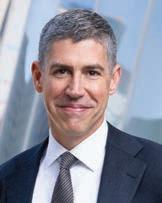
KEYNOTE SPEAKER:






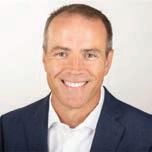

Brendan G. Carr, MD, MA, MS
Chief Executive Officer, Mount Sinai Health System
ADDITIONAL SPEAKERS:
Bunny Ellerin


Join Crain’s and Healthcare Financial Management Association, Metro NY Chapter (HFMA) for a day of live interviews and panels with the city’s top health care leaders and decision makers. We’ll engage in lively discussions on a wide range of topics, including regulatory changes coming to Medicaid and Medicare Advantage, the current state of the pharmacy benefit manager industry and how technology is reshaping the health ecosystem in the city.




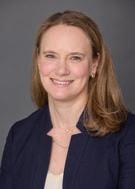
Co-Founder & CEO, Digital Health New York
Stephen B. Hanse, Esq
President & CEO, NYS Health Facilities Association I NYS Center for Assisted Living
Arel Lidow
Technical Co-Founder, Cedar

Wyley McCoy, PharmD, MBA
Senior Vice President, The Craneware Group
Tanvi Patel
Director & General Manager of Partner Services, Amazon Pharmacy
Nilay D. Shah, Ph.D.
Managing Director of Health Benefits, Analytics and Innovation, Delta Air Lines
Elisabeth Wynn
EVP, Health Economics and Finance, Greater New York Hospital Association


SUPPORTING SPONSOR









The National Association of Real Estate Investment Trusts conference is an annual pilgrimage for the industry to toast to better times ahead
Heavily indebted commercial real estate owners and their highly exposed bankers got together in Midtown starting June 3 for four days of mutual-support sessions.
e National Association of Real Estate Investment Trusts conference is an annual pilgrimage for 3,000 executives, investors and “industry partners” to make their case that better times loom ahead, at least for their company or client. An end-of-conference party at Mastro’s Steakhouse, inside the RXR-owned tower at 1285 Sixth Ave., was sponsored by Bank of Montreal, which has $70 billion in commercial real estate exposure.
going to two breakfast meetings, a lunch, a dinner and four cocktail parties. All these events took place in Midtown, a short walk from his Murray Hill home.

“Where else can you do that?” he said. “It’s why New York is still the place people want to be.”
True as that is, the issue before NAREIT conference attendees was that fewer New Yorkers are going to the o ce regularly than even nine months ago. e conferees’ collective wish that interest rates would come down this year isn’t working out, either. e longer cuts are delayed, the tougher it gets for landlords to re nance as billions worth of debts come due.
Wall Street’s leading astrologer, Henry Weingarten, wasn’t going to NAREIT’s investor conference. But he was going to three others last week. e managing director of e Astrologers Fund was also
“ e malaise of REITland is understandable,” said Piper Sandler analyst Alexander Goldfarb, who noted investors are pricing levels of calamity last seen in 2008, when developer Harry Macklowe de-
faulted on billions worth of loans and was forced to hand over the GM Building.
Goldfarb bets the outcome won’t be so bleak this time. He argues federal regulators won’t force banks to foreclose on large numbers of dud properties because that would in ict avoidable losses on lenders and borrowers when loans can still be modi ed. As the market comes to understand this as the most likely scenario — which is also the best-imaginable under the circumstances — it “should relieve CRE investors of impending credit doom,” Goldfarb wrote.
What are the odds of such a gentle landing? Never mind looking to the stars, Weingarten said. Look to interest rates.
Heading into this year he thought the Federal Reserve would cut them two or maybe three times and the

consensus was six. But in ation remains too high for the Fed to move and Weingarten said that, though the current 5.5% rate may be higher than many people remember, that was the average for decades.
“It all depends on what you’re used to,” he said.
Many landlords seem illequipped to cope with persistently high rates. Just about all sectors of the market rallied in reaction to April’s total solar eclipse, Weingar-
ten said, but o ce REITs continue to underperform. e sector rose just 1.7% over the last 30 days compared to a 2.9% increase for the overall REIT index, Evercore ISI said.
Is this the right time to be buying? Weingarten said it is for a speci c kind of real estate — gold mines — but it’s early to bet on rebound in o ce buildings. “ eir value? I can’t tell you,” he said.
Gov. Kathy’s Hochul decision to yank congestion-pricing revenue has caused an uproar reminiscent of the subway’s 2017 “summer of hell.” But one key player in this political restorm has been quiet as a churchmouse, at least so far: the bond markets.
Prices on the MTA’s $10 billion worth of tax-free bonds haven’t reacted since Gov. Hochul dropped her bombshell June 5, analysts say. No ratings agency has indicated it’s worried about the Metropolitan Transportation Authority’s ability to service its existing debt obligations, which currently reach $42 billion. One way or another, the nancial crowd believes, the legislature and governor will not let the MTA default on those debts.
But the MTA’s credit rating could be another story. e MTA has not yet sold bonds against the $1 billion in recurring revenue it was expecting from congestion pricing to raise an expected $15 billion for capital improvements. e approval of the tolling scheme was cited as a reason Fitch Ratings in March raised MTA’s credit rating to a near-pristine AA rating, citing the state as a reliable partner. e state “has demonstrated consistent and meaningful nancial support to the MTA during prior periods of stress,” Fitch said. “Evidence of [New York
state’s] support includes the recent increase in the maximum rate of the Payroll Mobility Tax…and authorization of signi cant subsidies for the capital plan including congestion pricing, internet sales tax and mansion tax.”
e MTA’s credit rating could be at risk over Hochul’s decision to inde nitely delay congestion pricing, because that raises questions over just how meaningful support will be in the future for the agency.
Yet Fitch senior director Michael Rinaldi said it’s premature to cut the transit agency’s AA rating.
“ e governor has signaled intent to come up with a plan,” he said June 7.
In the meantime, the MTA’s hard-earned nancial stability is in doubt because a governor panicked. Near-term, Fitch director Tammy Gammerman isn’t optimistic that lawmakers can nd a way to replace congestion funding given how long it took to get it approved in the rst place.
“To try to gure out something long term and sustainable in just a few days doesn’t feel very likely,” she said.
From Wall Street’s narrow perspective, nothing has been lost yet, since congestion pricing-related bonds haven’t been sold to investors.
“We don’t make rating decisions based on hypotheticals — what may or may not transpire,” said
Karen Daly, head of public nance at bond-rating rm KBRA. “ is is still very recent news.”
e Securities Industry and Financial Markets Association issued a statement June 6 that didn’t mention congestion pricing but warned lawmakers against raising taxes on nancial rms as another funding solution for the MTA.
But without raising business taxes it’ll be nearly impossible for the state to replace the $15 billion revenue opportunity a orded by congestion pricing.
“ ere is a longer-term question of how this funding gap will be lled,” said Ana Champeny, vice president at the Citizens Budget Commission. “It was supporting critical capital investment to keep the MTA in a state of good repair.” Congestion pricing e ectively would give the MTA a new line of credit after it exhausted the older one. For decades the agency issued bonds backed by farebox revenues. ose borrowings helped nance $125 billion worth of capital improvements since 1982. Even so, there never was enough money to adequately maintain the subway system, especially when ridership jumped because more New Yorkers than ever were going to work.
Years of neglect took their toll in

2017’s summer of hell, when the public transit network started to come apart at the seams. In one of many memorable incidents, on June 27 a southbound A train derailed near 125th Street, lling the tunnel with smoke and injuring more than 40 passengers. Two days later, Gov. Andrew Cuomo declared a state of emergency for subways and the Long Island Rail Road and a month later the MTA announced a “two-phase Subway Action Plan.” Phase 1, with an estimated cost of $836 million, focused on stabilizing and improving the system. Phase 2, with an estimated cost of $8 billion, was to modernize the system that relies on switching technology that’s more than 100 years old.
Long-delayed investments delivered real bene ts. After the 7
line’s signaling system was fully digitized, at a cost of $766 million, signal-related delays fell by more than half, according to the New York State Comptroller’s O ce. e state borrowed yet more to pay the work and by 2022 debt-servicing costs were chewing up 18% of the MTA’s budget. If the percentage grew further, the agency’s credit rating would have been cut and borrowing costs would have risen further, a problem congestion pricing was designed to prevent by creating a dedicated revenue stream for the MTA. It was the second such program after Albany enacted the Payroll Mobility Tax in 2009 and nancial analysts were pleased that the state was shielding more MTA funding from the legislature’s annual budget ghts.
e country’s largest co-living operator appears to be at death’s door.
Common Living, a “dorms for adults” housing provider founded in Brooklyn in 2015, led for bankruptcy protection on May 31, about a year and a half after European co-living operator Habyt acquired the company in a bid for global dominance.
According to some of the court documents, the company has between $1 million and $10 million in assets but between $10 million and $50 million in liabilities, and “it is desirable and in the best in-
terests of the company, its creditors and other interested parties that a voluntary petition be led.”
Technically, eight entities led for protection, but the list includes the names of shell companies used by Common.
O ering 7,000 rooms in more than a dozen cities but looking to quadruple its size in the next few years, Common was an early player in an industry that o ers a product resembling old-fashioned singleroom-occupancy hotels. Tenants lease rooms in apartments and share common areas such as kitchens; co-living landlords cover utilities and housekeeping services.
Common was also one of the in-

dustry’s success stories, surviving the shake-out that occurred early on in the pandemic, when the housing market froze, and actually expanding during that period by snapping up less-established startups including San Franciscobased StarCity in 2020.
Pro tability, tenant concerns
Investors liked what they saw. e company, founded by tech entrepreneur Brad Hargreaves, a Crain’s 40 Under 40 honoree in 2017, raised $113 million in venture capital funding through 2022 and also enjoyed nancial backing from New York developers and real estate rms such as Monadnock Development, Sugar Hill Capital Partners, and RAL Cos., according to the list of creditors submitted to the U.S. Bankruptcy Court in Delaware. Hines, Zillow and CoStar are also on the 37-page list.
Even after the 2023 merger with Habyt, investors continued to show support, pouring an additional $42 million into the combined company in fall 2023. Around that time, Luca Bovone, founder and CEO of seven-yearold Habyt, which previously focused on co-living sites in Europe

and Asia, spoke of the promise of the Common merger.
“Our new combined resources present a fully digital, easy solution to access rental properties across the world, something that has been historically derailed by endless paperwork or bureaucracy,” Bovone said in a statement. Habyt is not expected to be a ected by Common’s bankruptcy, news of which was rst reported by real estate data rm PincusCo.
Common, unlike many coliving players, did not own apartment buildings but managed them on behalf of landlords and tenants, a strategy that Hargreaves long held minimized risk. But Common does not ever seem to have achieved pro tability.
And in the past couple of years, the company came under withering criticism from tenants about intra-roommate ghts, unsanitary living conditions and lack of security, which led Common to double the size of its support teams.
In the wake of the concerns, Hargreaves stepped down as chief executive o cer in 2022 and was replaced by hotel industry veteran Karlene Hollomoan. roughout, though, the company maintained a bold vision about expansion. In 2022, when Common controlled 7,000 rooms in more than a dozen cities, it vowed to add an additional 18,000 rooms by 2027.
Common properties in Manhattan include 335 E. 27th St., a microunit rental tower in Kips Bay, and 215 East 124th St. in Harlem. e bankruptcy action was a Chapter 7 ling, meaning a judge will not seek to come up with a plan for Common to repay its debts but will liquidate the company’s assets.
An email sent to Hargreaves for comment was not returned by press time. And lawyer Daniel Astin, whom Common has enlisted to help with the liquidation, did not return a call.




Gov. Kathy Hochul’s decision to inde nitely postpone the Metropolitan Transportation Authority’s congestion pricing plan is a blatant display of political cowardice that prioritizes personal career longevity over public good. It is a decision that reeks of opportunism and a profound lack of leadership.
When did the role of a leader transform solely into a ght for political survival? Hochul’s actions suggest a careerist mentality, where the primary goal is to remain in o ce rather than to serve. By shelving a plan integral to the modernization of the city’s transit system, she has e ectively turned her back on more than 98% of city commuters who rely on this infrastructure. Her choice to cater to suburban discontent at the expense of the city’s needs shows a disturbing willingness to sacri ce the many for the few.
In a pre-recorded message — issued from a safe distance — the governor cited vague economic concerns and potential unintended consequences as reasons for her retreat. e act of going into hiding post-announcement only underscores the

lack of conviction and responsibility in her governance. If the congestion pricing initiative, which has been researched, debated and planned for more than two decades, is so easily derailed by gubernatorial whims, what future does any common-sense policy have under such faltering leadership?


exacerbate scal disparities without solving the underlying issue — adequate funding for critical transit infrastructure.
Hochul had alternatives she could have pursued. A temporary six-month pause or raising these concerns earlier could have shown a genuine engagement with the policy’s complexities instead of a last-minute capitulation. Instead, she chose the path laid out by public opinion polls, a path lined with political calculations rather than paved with the bold decisions New York desperately needs.
Moreover, the governor's proposal to po-
tentially increase taxes on businesses to ll the gaping budgetary void left by the absence of toll revenue is not just impractical; it’s fundamentally unfair. Businesses in the ve boroughs already contribute 44% of the MTA’s budget through real estate and other taxes, despite the MTA serving a far broader geography, stretching into Connecticut and New Jersey. is plan would
Steve Cohen’s bid for a casino at Willets Point is on life support after Jessica Ramos, a state senator who represents the area, announced she would not back legislation to allow Cohen’s project to move forward. Cohen had hoped to circumvent Ramos in the Legislature, but the Democrats there are deferential to any member who has an important land-use consideration in their district. Ramos, quite simply, will not be overridden.
ere has been a predictable outcry from proponents of economic development that Ramos, a proud progressive, is scuttling an important project over narrow ideological concerns. Other Queens Democrats, including Borough President Donovan Richards, have been boosters of Cohen’s $8 billion casino proposal, which would add on a hotel, concert hall and park space on the parking lot west of Citi Field. Since the lot lies on city parkland, the billionaire hedge-funder and Mets owner must persuade both the state Senate and Assembly to pass a bill to “alienate” the land and allow development.

only for a convention center, hotel and park — a compromise Cohen’s team has said would make the project a non-starter. But why? Why couldn’t Willets Point survive with a new hotel and nicer parkland, not to mention the a ordable housing and soccer stadium that will soon be constructed?
What, exactly, is a casino o ering northern Queens?
ere are moral and logistical arguments to be made against further casino expansion — local businesses certainly don’t bene t from all the money getting spent at video machines and food courts within a casino’s walls — but there’s also the more pressing reality that the market is oversaturated in the Northeast. Gov. Kathy Hochul wants to hand out three new licenses for downstate casinos, which may or may not generate the promised tax revenue and job targets, but the greater truth is that Cohen’s proposal never made much sense.
ders, why not start with those where gambling is already allowed?
Cohen, who is used to getting his way, never really cared about this logic. Even if Ramos decided to alienate the parkland for him, there was no guarantee he would get his Willets Point casino, which would still need to win one of just three licenses the state plans to award next year. Even if he did, his project would have probably ended up cannibalizing Resorts World, a few miles south on the Van Wyck Expressway.
Ramos said she would introduce a new bill that would alienate the parkland, but
Queens already has a racino at Resorts World, in Ozone Park, which could easily be upgraded to the status of full casino with table games. e same is true of Empire City in Yonkers. If licenses are already going to be doled out to downstate bid-
Crain’s reserves the right to edit submissions for clarity.
ere will be kicking and screaming about jobs lost and dreams deferred, but there’s plenty of development happening next to Citi Field already. More pressing are the city’s housing needs. A nearby City Council member, Shekar Krishnan, voted against the recent rezoning of Willets because only 1,400 units of a ordable housing will be paired with the soccer stadium. Given the enormity of the project and the tax revenue the city is sacri cing because Mayor Eric Adams chose to lease the land rather than sell it, a harder bargain could have been driven on the housing front. e city must nd a way to cre-
Her reluctance to stand rm on congestion pricing — which was projected to drastically reduce city congestion, enhance livability, and contribute signi cantly to combating global warming — represents a failure to champion transformative change. e repercussions extend beyond immediate political fallout; they signal that the city will stall instead of progressing toward world-class status.
New York needs leaders who will stand for something greater than themselves. is moment was a test of leadership, and Hochul failed decisively.

ate and subsidize more a ordable housing on that land — and in the rest of the borough.
In the meantime, Hochul and local politicians have to stop defaulting to casinos as viable, long-term economic development models. Given the number of gambling options that exist already, including mobile sports betting, it’s unclear if any of the downstate casinos, when they come online, will deliver on revenue targets. e upstate casinos opened under former Gov. Andrew Cuomo have been relative duds. ere’s more money to be made in the Tri-State, but also far more competition for dollars and attention. Casinos are never going to be a safe bet.
Ross Barkan is a journalist and author in New York City.
On June 12 the New York City Council will be holding a hearing to consider Intro. 360, legislation that would require the individual who hires a residential property broker in a home rental transaction to pay his or her fee. At face value, this likely seems simple enough and agreeable to most New Yorkers. However, as we real estate advisors tell clients before signing on to any deal, or our own kids before making any signi cant decision, you need to look before you leap.
is bill would be a lose-lose for renters and agents, as it would increase rents and make it harder to apply for an apartment, while also creating a more challenging environment for agents to be paid for their work.
As we see working with property owners every day, most “no-fee” apartments do not absolve the renter from paying broker compensation. If not paid directly by the renter, landlords most often include broker fee costs in rents.

apartments at higher rents inclusive of broker fees will not be a challenge for owners. e Councilmember sponsoring this bill has even acknowledged that the result of this legislation would be that many landlords would include broker fees in rent, arguing that the cost of a broker fee would be more manageable for the renter if paid over the course of the initial lease term rather than on signing day. is is shortsighted.
Hal D. Gavzie is the executive vice president of Residential Leasing at Douglas Elliman Real Estate and a member of the Real Estate Board of New York. e views and opinions expressed are solely his own and do not necessarily re ect the views or opinions of his employer.
e reality is few owners have the time or interest in handling the work that brokers do and recognize without them apartments will not be marketed, shown and leased with the level of detail and e ciency that bene ts landlords and renters alike. With the current rental housing supply in New York City so far behind demand, market history suggests leasing
While deferring broker fee costs may o er momentary nancial relief for some, by baking fees into rent you are creating three negative consequences for renters. Immediately, you are in ating average asking rents that would limit negotiating power for renters in an already competitive market. Additionally, this bill could also impact housing access. With a higher base rent, more renters will not meet the income requirement to apply for certain units, thus further limiting their options. Finally, by including a previously one-time payment now in rent, renters will again pay the cost of the broker fee each year they re-sign their lease.
For brokers, this bill makes an already hard job more di cult. Despite what some supporters of this bill think, we do a lot more than unlock doors to help a potential
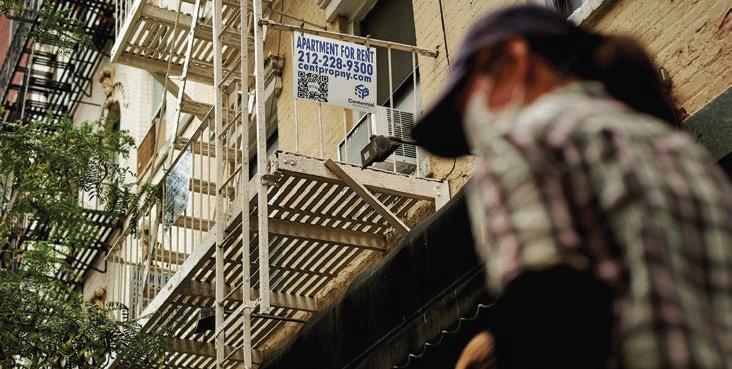
renter view an apartment. We put signicant time and resources into multimedia marketing of properties, market analysis to advise on rents, applicant screening, research and canvassing on behalf potential renters, showings, preparation of lease documents and coordination of apartment turnover, among other services. is legislation would disincentivize landlords from working with brokers, which means we could do all that work without guarantee of payment if we identify a successful applicant.
Residential real estate is a customer service-driven business. Renters are our customers, and we want the best outcome for them through the entire home search process. is legislation would have additional
negative unintended consequences for renters even beyond those highlighted in this piece, but none as devastating as the impact on apartment rent growth and access.
If legislators want to curb rising apartment costs, they should support tools to create more housing inventory to keep up with demand. Continuing to advocate for failed ideas like Intro. 360 distracts from addressing the real causes of housing cost increases while punishing hardworking brokers and creating a more challenging environment for renters.
Five years ago, thousands of brokers showed up to City Hall to push back against similar legislation. We plan to do the same this year for both our customers and livelihood.
Sometimes in life, you just know the right thing to do. You might ght the instinct and overthink it, and do something else. But you’ll know all along the line that you should have followed your heart. It’s true in love. It’s true in business. Turns out, it’s also true in matters of parks and public transportation.
I’m reminded of this simple truth every day as my wife and I run our New York events and catering business. We closed a restaurant in Midtown during Covid— because we could read the writing on the wall. en we came out here to Forest Hills in Queens. My rst ever mentor in the food business wanted to sell us his restaurant, and again, it just felt right.

Yvan Lemoine is the chef and owner of My Kitchen Restaurant and Banquet Hall in Forest Hills, Queens.
Instead of serving commuters, we would serve community members. With the shift to more remote work, we’d cater to more people living and working in the local area. We’d do baby showers. We’d do sweet sixteen parties and christening celebrations. We’d save on sta overhead by only opening the space during events, and we got down to business. So far, God-willing, it seems to be going well.
We began during the pandemic recovery, hosting a plethora of weddings. ose who delayed getting married during Covid wanted to seize the moment and get on
with things. One such wedding sticks in my mind. An older couple nally married after a lifetime of wrong choices. ey were high school sweethearts but ended up marrying other people. en they had children, raised them, and then, they each got divorced. Finally they found each other and realized they had always been each other’s true love. ey celebrated in our event space and it was a wonderful occasion. e couple told me their story when they were looking for a space, and I warmed to them both in a heartbeat. e moral of their story? Again. Trust your instincts.
Right now, Forest Hills faces another great opportunity to do that. e Federal government has given us $117 million in in ation-reduction funding. e money will fund the overhaul of a long derelict rail line and turn it into a public park. e Queensway will o er local residents and businesses more green space. Its bene ts are obvious and we should get on with it. A High Line-like park linking local people and businesses is a fantastic opportunity. Meanwhile, some are continuing to insist that there’s another viable option. ey

want the city to pursue turning the old rail line back into an extension of the Long Island Railroad. at’s despite the Metropolitan Transit Authority saying such a thing would cost $5.7 billion. It would attract only 2,000 new daily riders to the line each day, for total daily riders of 39,200—by comparison, the 6 train carries more than 350,000 people each day—and the Queenslink wouldn’t enhance an area already served by public transit. e Woodhaven Boulevard Select Bus Service runs parallel to the proposed route.
As a business owner in Forest Hills, I’m
asking myself an obvious question. Should we delay an incredible opportunity and instead, further study this alternative? e state has set aside $10 million for an environmental impact study. Of course people are welcome to look into the idea as long as they want. e Queensway doesn’t rule out transportation in the future. But the last time that rail line was running, e Beatles were releasing “Love Me Do.” And so much has changed in the 60 years since. It’s a lifetime. I am keen for us to avoid going further down the wrong road for another generation.
Clune Construction
Clune has promoted Mike Camier to Vice President. Camier’s career in construction began over two decades ago with Laborers Union Local 79. From laborer to Superintendent, he has thrived in high-pressure environments, leveraging his ability to stay focused and deliver exceptional results. Camier excels at optimizing operations and implementing cost-saving strategies while supervising a workforce of over 50 laborers. His commitment to excellence drives success on all projects he manages.

Clune Construction
Clune has promoted Patrick Dwyer to General Superintendent, Senior Vice President. He was one of the rst employees hired to establish Clune’s New York of ce, which allowed him to create a robust structure when developing Clune’s eld staff. Known for his strong work ethic, accuracy, and ability to overcome complex challenges, Dwyer nds building a strong foundation in New York for the next generation to be the most gratifying part of his job.

To place your listing, visit www.crainsnewyork.com/people-on-the-move or, for more information, contact Debora Stein at 917.226.5470 / dstein@crain.com
Clune Construction
Teddy Kalaboukas has been promoted to Vice President at Clune. Kalaboukas’ proactive approach and extensive experience in project management and eld operations have increased project ef ciency and fostered mentorship within the team. Among his notable achievements is the successful management of the logistically challenging concourse improvement projects at LaGuardia Airport. Kalaboukas is recognized for his composed demeanor, detailed communication style, and thoughtful leadership style.
Activate Consulting
Activate Consulting (Activate), the leading management consulting rm for technology, internet, media, ecommerce, entertainment and sports companies, announced that Cigdem Binal has been appointed Associate Partner. Cigdem works with media and technology companies to de ne growth strategies and improve business performance through product, pricing, new business and go-to-market strategies. She also works with private equity rms on strategic due diligence and performance improvement.

Orion Innovation
Kelly Ercolino joins Orion Innovation as the Senior Vice President of Marketing. With two decades of experience in technology industry marketing, including roles at Tata Consultancy Services and Coforge, she will lead Orion’s strategic marketing function to achieve the company’s revenue and growth goals. Before joining Orion, Ercolino was a marketing strategist and consultant for several high-pro le technology companies.



Clune Construction Clune has promoted Danny Mastropierro to Vice President. Although his career in the industry began as a union laborer at age 18, his journey with Clune Construction began in 2017 as a Superintendent. He quickly rose through the ranks due to his ability to meet tight deadlines and his aptitude for mentorship. Mastropierro is known for his expertise in managing aggressively scheduled high-end buildouts in some of the city’s most notable buildings.

Clune Construction
Clune has promoted Eric Sugarman to General Superintendent, Senior Vice President. Over his nearly four-decade career, Sugarman has excelled at building logistically challenging projects in and around New York City, most recently overseeing a portion of the complex terminal improvements at LaGuardia Airport. Dedicated to mentorship, he leaves a positive impact on projects and colleagues and continuously strives for excellence.


Schwarzman Animal Medical Center
Schwarzman Animal Medical Center (AMC) announces the promotion of Dr. Philip Fox, longtime Service Head of Cardiology, to Chair of the hospital’s Caspary Research Institute, which aims to advance veterinary medicine through promoting clinical research. Dr. Fox is an internationally recognized leader in cardiology and research, with a distinguished career spanning over four decades. His expertise and leadership will promote the development of a new and important research department for AMC.

Latham & Watkins LLP
Douglas Heitner has joined the New York of ce of Latham & Watkins as a partner in the Real Estate Practice. He advises clients on a range of real estate transactions, including joint ventures, nancings, developments, and public and private projects. Previously the Chief Legal Of cer at a New York-based REIT, he brings a unique perspective on the industry and associated market trends and legal developments, with a focus on real estate private equity and publicly traded real estate companies.
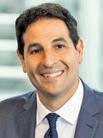
EisnerAmper eisneramper.com
Global business advisory rm EisnerAmper announces a pair of recent combinations with award-winning rms. Boston, Massachusetts-based CPA rm Edelstein & Company, LLP, is joining EisnerAmper. Founded in 1968, Edelstein has 11 partners and a staff of 150+. It offers accounting, tax, and consulting services across varied sectors.


Also, Birmingham, Alabamabased tax, assurance and advisory, and real estate consulting rm Tidwell Group, LLC, is joining EisnerAmper. Founded in 1997, it has 40 partners and a staff of 200+. Tidwell has six of ces across Alabama, Georgia, Texas, and Ohio. It has a strong presence in real estate, affordable housing, HUD and USDA-rural development compliance, renewable energy projects, and construction.









THOSE WHO WOULD QUESTION the work ethic of the next generation of business professionals have not met these hungry, young New Yorkers. They are making a name for themselves in entertainment, real estate, health care, tech and politics, thanks to their big ideas and fresh perspectives. They are proving that they are not afraid of tackling hard tasks, from nding new ways for a real estate rm to use data to ensuring small-business owners can raise capital to blowing the roof off a Broadway theater night after night. These 20 rising stars are shining bright, and New York is seeing the bene ts. Read on to learn more about how much they’ve accomplished already — and what still lies ahead.
PHOTOGRAPHS BY BUCK ENNIS

—TELISHA BRYAN, MANAGING EDITOR CrainsNewYork.com/awards/20-their-20s-2024
Company artist and social media coordinator, Dance Theatre of Harlem
It would be easy for a professional dancer to wonder “What now?” during the Covid-19 quarantine. But not Dance Theatre of Harlem’s Derek Brockington, who added marketing to his duties, crafting content for social media. He also co-created “Dancing Through Harlem,” a video celebrating both the company and the often-overlooked beauty of its namesake neighborhood. Repostings of the video by Janet Jackson and others helped it go viral and eventually end up on “The Ellen DeGeneres Show,” where Brockington and his colleagues brought wider attention to the storied company.
“It’s been incredible seeing how this work resonated with so many people,” said Brockington. He includes in that group his mother, who adopted him and his previously unrelated siblings.
“Mom is white, and her only connotations of Harlem were from the riots. For her and others to see these incredible spaces — places many didn’t know existed — that was a beautiful part of it.”
“ Find an outlet for your ideas. Get them out. It doesn’t matter how
or
where. Get those ideas out. Perseverance is the key to success.”
Brockington, who grew up in Michigan, joined the theater in 2018 after stints with the Grand Rapids Ballet and Cincinnati Ballet II. With Dance Theatre of Harlem, he said, “I was able to come into my own in a place where people looked like me. It opened my eyes and gave me a broader perspective of the world and who I was as a Black dancer.”
During the current season, Dance Theatre of Harlem will have performed in about 30 cities to nearly 100,000 people. This season Brockington has had principal roles in George Balanchine’s “Pas de Dix” and Robert Garland’s “New Bach,” among others. And he’s had featured choreography in the company’s Sunday matinees.
Brockington also nds opportunities to engage with the Harlem community. Recently he helped plan a charity drive that brought in 160 coat donations.
“DTH gave me this history that I could relate to and feel connected to. It gives me a sense of what’s possible, what’s been done and what I can do,” he said. “That fuels my re.” — LOU HARRY





Chief strategy of cer, Kasirer
Michael Braun went to SUNY Cortland because it was a great baseball school, and he wanted to build on the center elder chops he’d developed at Elmont Memorial High School. But then he got hurt, was cut from the college team and thought life was over.
“I really took a step back to think about what I enjoyed,” Braun said. “It was representing people and having an impact on people you care about.”
He’d had a taste of that as student government president in high school. Soon he was serving as president of the SUNY Assembly, speaking around New York to thousands of state university students, as well as serving on the SUNY Board of Trustees as a student rep.
Someone told him about an opening at the lobbying rm Kasirer, and Braun was hired as an associate there in 2019.
His hard work and eagerness to build relationships made him stand out, says Suri Kasirer, the rm’s founder.
“
“He’s willing to jump in and think through complex challenges and come up with creative solutions,” she said.
Day to day, he might be guiding a residential developer through an approval process or advising a company on how to position itself for a bid with the Metropolitan Transportation Authority.
Sure, Britney Spears had a hit with “Oops … I Did It Again.” But it was Lorna Courtney who sang it again and again, eight times a week, as Juliet in Broadway’s hit “& Juliet.” Critics spoke of her “con dence and swagger,” noting her “powerful belt” and singing voice “scraping the rafters on showstopper anthems.” Tony and Drama League award nominations followed for this “tiny dynamo” who seemed to come out of nowhere. In her case, “nowhere” meant understudy, swing and chorus roles in “Dear Evan Hansen” and “West Side Story.”
When the pandemic put theater on hold, Courtney admits she questioned her career choice. But she took online acting classes and performed in virtual concerts. When the industry started ramping up again, she selfrecorded audition tapes.
Seven callbacks for “Jagged Little Pill” didn’t land the gig, but it opened a door: Its producer also was working on “& Juliet.” Courtney cried and laughed while reading the script, auditioned and got the part. Acclaim, award nominations and even a chance to sing with Elmo of “Sesame Street” followed.
“ I didn’t have the relationships or connections or expertise or knowledge of some of my colleagues in this industry. But if I have to develop that relationship, I will. If I have to do the research, I will.”
What’s beautiful about theater is that it’s live. Mistakes happen. We come as we are, whether we aren’t feeling well or just had a bad breakup.”
Leaving the show in May wasn’t easy, but Courtney felt ready to move on. “I was blessed with the opportunity to tell this story for the past two years,” she said. “I’ve grown and changed because of it. But it was my decision.”
Now she’s taking time to work on her own music, exploring solo concerts (she spoke with Crain’s while headed to rehearsal for a gala at the American Museum of Natural History) and prepping for a run at Princeton’s McCarter Theatre in the new musical “Empire Records,” opening in September.
— LOU HARRY
One client he brought to Kasirer is Special Olympics New York. Its president and CEO, Stacey Hengsterman, knew Braun when she was chief of staff to then-SUNY Chancellor Nancy Zimpher. Hengsterman told Braun she would like to see her organization more involved in the city public schools. He made an introduction at a breakfast where Schools Chancellor David Banks was speaking. Now, Hengsterman said, student participation has doubled in a year.
Braun doesn’t recall a time when he wasn’t passionate about being involved. “I just think I’ve always wanted to step up to the plate,” he said.
—ANNE
 MICHAUD
Actress, Broadway
MICHAUD
Actress, Broadway
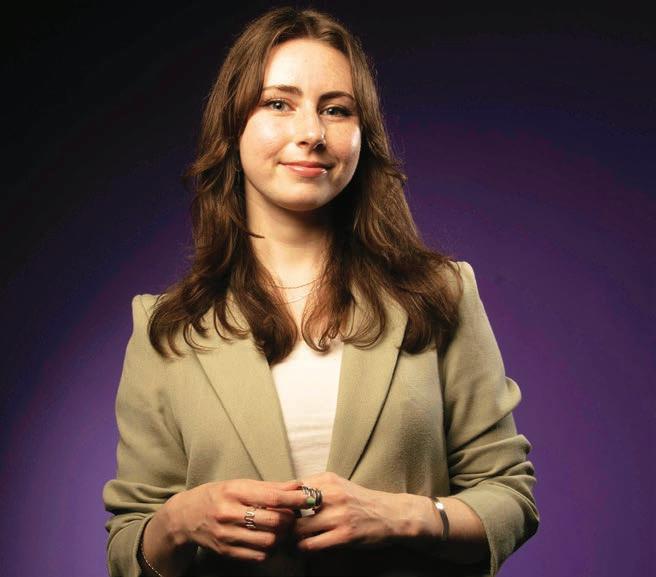
Co-founder and managing partner, Aegis Ventures
Planning and advocacy manager, Permanent Citizens Advisory Committee to the MTA
For as long as she can remember, Kara Gurl has been passionate about making a difference for New Yorkers who rely on public transportation.
At 11 years old, she realized it took less time to walk along her city bus route in Brooklyn than it did to ride to school. “There was this public transportation system that was supposed to get me where I had to go, but it didn’t always work,” she said. “It was a formative experience for me as a rider and eventual advocate.”
Today Gurl campaigns for riders and conducts research on transit as the planning and advocacy manager for the Permanent Citizens Advisory Committee to the MTA. Though part of the Metropolitan Transportation Authority, the group functions as an independent watchdog.
In almost three years with the committee, Gurl has notched notable achievements. Last year she helped raise the eligibility threshold for half-fares to those whose income falls under 120% of the federal poverty level. And this year she is working to help more people qualify for discounts through the city’s Fair Fares program.
“I take Kara everywhere I go,” said Lisa Daglian, executive director of the committee. “I feel fully con dent bringing her to events with the governor, mayor, head of the MTA and to testify at different hearings.”
Already successful in expanding the city’s fare-discount program to commuter railroads during peak and off-peak times, Gurl is working to further increase the affordability of the commuter rail system. “We want to make sure people in the Bronx and Queens, with faster commutes available to them through the Metro-North and Long Island Rail Road, can afford access,” she said.
Gurl imagines spending the rest of her career improving the transit system. “I think the public sector is a unique way to effect change,” she said, “through working with public servants, elected leaders and people who go to work every day.”

“
ohn Beadle always wanted to go into health care. “My mom was incredibly sick with a traumatic brain injury,” he said. “Seeing her struggle trying to access health care motivated me since childhood.”
Rather than go to med school, though, Beadle found his way into the industry through investment banking. “My goal was always to develop core capabilities in private equity so that I could specialize later on.”
That “later on” happened fairly quickly. He founded Aegis Ventures in 2020, determined to nd solutions to major health care challenges.
“We work backwards from our partners,” he explained. “We typically try to focus on nding what the needs are.” Those range from using tech to make scheduling appointments easier to developing a cheaper, quick retinal scan system for the early detection of diseases. Can AI be used to help make virtual care and call centers more empathetic? Beadle is determined to nd out. One recent project was leading the formation of Aegis Digital Consortium to bring together nine leading health care systems to build and scale companies to address such issues.
“We’re focused on evidence, all peer-reviewed and clinically vetted. And we build tech around the world’s leading scientists.” Every project, he says, goes through stages, starting with, “This looks interesting. Let’s put $100,000 into it, build an early prototype, put it in front of end users, do some business planning and see the competitive landscape and how this ts in. From there, we can move forward and get to a place of incredible con dence or we can kill it before we write the $10 million check.”
But nancial payoff isn’t the only priority. “We’ve always been big believers that there’s not a necessary contradiction between making money and making the world a better place,” he said.
— LOU HARRY

Director of strategy, Casamata
Long Island native Robyn Tse knows her way around a kitchen. She’s spent time working in restaurants — both in the back and the front of the house — all around the world. She rst got a taste for the industry in New Haven, Connecticut. As a freshman at Yale University studying psychology, Tse and a few friends started a fully equipped and staffed restaurant on campus. They would serve about 100 of their classmates each week and come up with a different concept every semester.
“I think that’s sort of what kicked it all off. It was super fun,” she said. “We took ourselves far too seriously.”
From then on, Tse couldn’t get enough of the fast-paced environment. During college, she spent a semester abroad, and some summers in between, cooking at internationally acclaimed restaurants, such as Noma in Copenhagen and Belon in Hong Kong. Her rst job in a professional kitchen was at ABC Kitchen in Manhattan.
Tse pursued her MBA at Stanford, during which time she continued learning about restaurants’ daily operations and long-term strategies. She became passionate about tipping policies and the impact they can have on workplace cooperation and the guest experience; she even penned an op-ed in The New York Times about the welfare of restaurant workers.
“ Investing in your skill set will pay signi cant dividends if you do it the right way.” I would really emphasize how important it is to gain hands-on experience in the industry.”
After Stanford, Tse landed her current role as the director of strategy at Mexican restaurant group Casamata, which operates 17 concepts, ranging from ne dining to fastcasual taquerias, across the U.S. and Mexico. In New York, the eateries include Cosme in the Flatiron District, ATLA in NoHo and Esse Taco in Williamsburg.
Tse, who now lives in Chelsea, plays a pivotal role in executing the group’s strategies — such as planning for the future and laying the groundwork for effective collaboration.
“But I de nitely pop into the restaurant on a regular basis,” she said of Esse Taco. “Last week I was covered in guacamole.”




Growing up in a family of doctors, Ben Normatov was told at a young age that’s what he’d eventually be, too. He took courses in college to become a physician assistant, but his heart just wasn’t in it.
“I did two years of prerequisites, and I hated every minute of it because it’s just not me,” said Normatov. “I love sales.”
In high school and college, Normatov sold music beats he produced online to artists all over the world. After that came selling jewelry — rings, necklaces and bracelets he found in the Diamond District and then would ip on eBay. Then he discovered the vast world of real estate and realized he could turn his passion into a career.
Normatov grew up in Israel and moved to New York City in 2007. He fell in love with the size and scale of the city’s buildings — something he hadn’t really seen in Tel Aviv.
“Moving here and seeing the real estate really just sparked a passion in me,” he said.
Normatov graduated magna cum laude from the Zicklin School of Business at Baruch College with a bachelor’s degree in business administration and started his career in residential real estate. He then quickly transitioned to the commercial side because, he said, it was his dream to “always just go big.”
He joined the Brooklyn-based rm Alpha Realty on the investment sales team in 2019 and is now the team’s director. He has sold close to $100 million in commercial real estate to date. He specializes in the sale of all asset classes, speci cally in Cobble Hill, Park Slope and Carroll Gardens in Brooklyn and in Astoria, Sunnyside, Rego Park and Forest Hills in Queens.
The same year Normatov started at Alpha Realty, he was featured in the New York Real Estate Journal’s “2019 Ones to Watch.”
“I see myself brokering some of the biggest buildings in New York City,” he said.
When he’s not closing a sale, Normatov loves spending time with his family — he lives in Rego Park with his wife and children — playing Ping-Pong and chess, going on bike rides and traveling the world.
— JULIANNE CUBA

Assistant virtual design and construction manager,
Julie-Ann Evans has known she wanted to work in construction since childhood, and growing up in the city was a big reason why.
“I’ve been watching the skyline change,” she said, “and I always thought it was cool peeking into construction sites and seeing all of the activity going on.”
Evans initially thought architecture might be her path into the industry before realizing it involved too much of ce work for her liking. She learned more about construction management at New York University and found it appealing, as it let her be on job sites fairly often and see the results of the work that goes into building major developments.
She landed an internship at the construction giant Skanska while in college and started working there full time after graduating. She is still at the company today as an assistant virtual design and construction manager, researching how new technologies such as water drones can improve the way Skanska completes projects.
Evans has a background in marine construction, and one of her highest-pro le projects was helping prepare for the arrival of the U.S. Naval Ship Comfort, which served as a temporary hospital for the city in 2020 during the initial wave of Covid. Although this was a scary time, she was grateful to be able to help New York.
“I’m not a doctor. I’m not a nurse,” she said. “But to be able to be there to support the city in any way I could felt really good.”
“
Always ask questions, and never stop learning. Even when you’re learning so much, and you know so much more than what you knew a year ago, there’s still so much more to learn.”
Construction is an infamously male-dominated eld, but Evans said she has started to see more women join. Letting girls know at a young age that this is a viable career option will be key to diversifying it further.
“You don’t have to be a manly girl or a manly woman to be in construction. You don’t have to change who you are,” she said. “My voice isn’t loud or deep, but that doesn’t mean what I’m saying isn’t important.”
It was inside a Bayside, Queens, yoga studio that Lauren Curcio found her calling.
Nine years ago she was an instructor trying to gure out what to do because college wasn’t exciting her. The studio’s landlord needed someone to answer the phone and handle paperwork, so she raised her hand. Before she knew it, she was in regular conversation with insurance agents, engineers and everyone else who rang to talk about her new boss’s properties. She discovered she loved property management.
“I go 100%,” she said, “even if it’s ling documents for eight hours.”
She started showing apartments and realized she loved that side of real estate, too. After a year and a half of work in Queens, she summoned up her nerve and sent a cold email to a Manhattan broker at Compass she admired and asked to work alongside her. Five minutes after they met, she was hired.
Specializing in the retail, of ce and specialty industrial markets, Curcio’s focus is helping businesses nd just the right property.
She found of ce space on Park Avenue for an investment rm and a Financial District of ce for a law rm. She also helped a construction company in Far Rockaway nd a warehouse closer to Manhattan, in East Williamsburg. Altogether she has leased 260,000 square feet of commercial real estate, or about $40 million worth of leases, and executed more than $20 million in sales.
She also helps certain clients nd residential investment properties. She was involved in the redevelopment and rezoning of the Lofts at 300 Richardson in Williamsburg and says she has leased the entire building, including the adjacent warehouses on the block.
She works around the clock but never gets tired, she says, and de nitely never bored.
“I have no family ties to real estate,” she said. “All this I did from the ground up.” — AARON ELSTEIN

“ I’m a culmination of my network, whether it be my mentors, my colleagues, my friends or just people I can lean on for advice.”

Manager, operations, department of surgery, trauma and critical care, Northwell Health’s South Shore University Hospital
Andrew Adrian was less than two years into his health care administration career at Northwell Health’s South Shore University Hospital when he was asked to open a monoclonal antibody infusion center to help people at risk of contracting severe Covid-19 during the height of the Delta variant outbreak.
Adrian, who was 24 at the time, was a part of Northwell’s management associate program and in the early stages of his career. Suddenly, he found himself making decisions to move an entire infectious disease clinical unit across South Shore’s campus.
“It really prepared me in terms of knowing I had the skills to gure it out,” Adrian said. “I knew I had a network to lean on, too.”
The experience launched Adrian’s career in health care administration. Now he manages operations within the department of surgery, trauma and critical care at South
Shore University Hospital, overseeing 15 surgical departments.
Every day is different, he said, whether he’s allocating medical equipment or managing the onboarding of new surgeons. “It’s like constantly solving a puzzle.”
Although Adrian always felt called to work in health care, he didn’t necessarily see himself behind a desk. He studied athletic training as an undergraduate at Hofstra University, thinking he’d become a physical therapist. But after working in a few clinics, he realized he wanted to tackle systemic health care challenges and stayed at Hofstra to pursue a master’s in health administration. His mission to provide excellent care to patients drives his work. “If you continue to put the patient’s best interest at the forefront of every decision, you can basically gure out any puzzle,” he said, “and know that you’re doing it the right way.”
—AMANDA D’AMBROSIO







































FDon’t wait for anyone to give you permission. Just go ahead and do it.”
Chief of staff, Volunteers of America—Greater New York
N“ The way you can be most impactful in the human services sector is through servant leadership and really thinking about how you can be supportive of your colleagues and the clients served.”
ew York City is facing a series of crises — a lack of affordable housing, unprecedented levels of homelessness and high food insecurity, to name a few — and the nonpro t human services sector is doing all it can to keep up with the demand.
Nick Brasse serves as chief of staff of one such organization, Volunteers of America—Greater New York, which aims to support people in need of housing, health and wellness services. The nonpro t provides affordable housing for people facing homelessness as well as supportive housing for the region’s aging population and those facing domestic abuse, among other initiatives.
Brasse is putting all his energy into addressing these issues as well as inspiring his colleagues to use “all of their effort, all of their talent, all of their expertise” to help New Yorkers — for as long as it takes.
“It is not a six-month thing,” he said. “It’s the ght over these next few years to live up to the promise of our city and to help folks really embrace our obligation to each other.”
Brasse’s responsibilities within the organization change daily. He directly supervises 11 staffers and oversees strategic initiatives and public policy, works on fundraising and attracting donors, and handles marketing and communications work. But his priority is always supporting the front-line staff.
“The folks who work in social services are so resilient,” he said. “They are always doing more with less.”
“
or Alex McOwen, a producer at Lemonada Media, going through 17 versions of the trailer for the second season of Julia Louis-Dreyfus’ podcast, “Wiser Than Me,” before landing on the perfect 3 minutes and 11 seconds was a labor of love.
“It’s exhausting, but every editorial decision should be intentional,” McOwen said. “It’s important to me when starting something new, or even working on something that’s existed for a while, knowing what your purpose is, knowing what you’re trying to achieve with everything.”
Staying focused on the purpose behind the podcast, and all the details that entails, is also part of the producer’s job description. “Everything you see or hear on the podcast, I have touched,” she explained, “except it’s not my voice.”
Four years ago, McOwen joined women-owned, women-led Lemonada, working on many projects including as part of the team on Louis-Dreyfus’ show, which the company describes as “hilarious and intimate conversations with iconic women, brimming with wisdom and the kind of attitude that only comes with age.” The podcast has received numerous awards and was named Apple Show of the Year in 2023.
“We were a very young company when she joined, and her impact was immediate,” said Kryssy Pease, a senior producer at Lemonada and McOwen’s former manager. “She brings humor, thoroughness, creativity and heart to every project she works on.”
McOwen is not disillusioned by the current state of the podcasting industry, which saw a record number of layoffs and shows canceled in 2023. She credits her drive, belief in the industry and supportive mentors for her ability to keep doing a job she loves. As she enters the next phase of her career, McOwen is eager to pay it forward.
“I would love to be able to do that for someone else now that I’m a little bit further in my career and I’m in a place where I actually might have something to teach someone,” she said. “I would love to be able to bring new people in and support people coming into this industry.”
When Brasse was in elementary school, he joined Prep for Prep, an organization that provides intensive educational support to young people of color. This opportunity gave him a scholarship to attend a specialized high school, setting him on his professional path.
“My decision to go into the nonpro t sector after college was really easy because it did so much for me,” he said. “I saw rsthand just how transformational that impact can be, and I wanted to be a part of that and wanted to help contribute to that change in other people’s lives.”



“ I’ve leaned into my voice and have grown, which has opened up opportunities and allowed me to foster strong relationships.”
Senior product manager, Progyny
After working in product development at technology giant Cisco for ve years, Alisha Ghosh shifted her career to focus on the end user — everyday people like herself.
In 2022 she joined Progyny, a fertility, family building and women’s health bene ts provider used by employers and insurance plans nationwide. “I took the experience I had with products and married it to a sector that is so incredibly underserved: women’s health,” she said.
At Progyny, Ghosh oversees bene ts products for women’s health needs. She describes her role as having two parts: First, she brings products to the market so that patients can realize their wellness dreams. Second, she monitors and re nes Progyny’s products to deliver the best possible experience.
In less than two years, Ghosh has been recognized for her can-do approach.
“She jumped right in and worked on launching products for pregnancy, postpartum and menopause — new bene ts beyond fertility,” said Mae-ellen Gavin, group vice president of products at Progyny. “She showed up with a positive attitude and lots of energy, willing to admit what she does and doesn’t know while displaying resilience.” If something isn’t working, Ghosh is known to pivot and nd another path.
Recently, Ghosh and her team were successful in launching Progyny’s menopause products, bringing awareness and education to a topic that affects more than half the population.
“It’s very gratifying to see that we are serving an area that has not been historically met,” said Ghosh. “I feel passionate about bridging the gaps in menopause care to bust taboos and really destigmatize that conversation.”
Ghosh feels at home working alongside individuals seeking to change the status quo. “The work can be dif cult,” she said, “but I want to raise awareness and increase access to women’s health care.”

Ian Stern didn’t have business development on his career radar in 2021, when he wrapped up his master’s degree in urban planning, but he cared about building healthy communities. At the University at Buffalo, he co-authored an article about Covid-19’s disproportionate impact on low-income people of color, and he planned to move to New York City to put his beliefs into action.
He landed at the Greater Jamaica Development Corp., a community-building nonpro t formed in the 1960s to encourage investment in underprivileged parts of southeastern Queens.
“I didn’t have a background in business at all,” Stern recalled. But as it turns out, helping small-business owners navigate bureaucracies and wade through cumbersome applications is a sure re way to steer resources toward those who need them most.
Stern began as an associate focused on giving technical assistance to small businesses applying for nancing. He was later promoted to manager of industrial business services; his clients range from homebased candlemakers to screen-printers to contractors bidding for jobs at JFK International Airport.
Above all, Stern’s clients share a struggle with accessing capital. He helps them tackle that by pushing them to become certi ed as minority- and women-owned business enterprises and walking them through upcoming regulations, such as the city’s Local Law 97.
Stern maintains a wide set of skills: He is uent in Spanish, taught himself to code in R and recently completed a certi cation in GIS, a geography software. And he’s more than content at Greater Jamaica, where he’s doing the kind of work to uplift the community that he always hoped to.
“I don’t know that there’s a better place to be, honestly,” Stern said. “There’s certainly a lot to address when it comes to disparities at the community level.”

Growing up in a low-income neighborhood in Garland, Texas, Nia Carter recognized early on that access to technology was critical. In high school, whenever she traveled to debate competitions and other events, she saw that students with laptops and iPads ended up performing better.
At Vanderbilt University, Carter studied the intersection of computer science and policy. With plans to become a lawyer, she applied for an internship in Google’s legal division but instead was placed in its PR and communications group.
“It was there I realized that I could make an impact on society without being a lawyer,” said Carter. During her internship, she worked on Google’s Pixel products.
“The message we were trying to convey was that technology doesn’t have to be premium,” she said. “It could be something that is affordable and accessible to everyone.”
Now a lead PR rep at Google, Carter is responsible for external communications for Android Developer, a suite of tools to design applications for Android devices, and Google Play, the tech giant’s online digital media store. In her role, she is committed to telling the stories of the people behind the products through initiatives such as #WeArePlay, a blog that highlights Google developers’ vision. For Women’s History Month, Carter featured four women founders, among them someone who created an anxiety- and panic-relief app.
“ Don’t
be afraid to go out of the box. If you try to truly build relationships with reporters and understand what they’re looking for, you can gure out how to be more authentic and creative.”
Additionally, Carter is involved in the Google for Games Developer Summit, which provides free access to resources that teach developers how to use the latest technology, including Al.
“Nia has a keen ability to understand technology and communicate it for the everyday person in a way that isn’t condescending,” said Nicol Addison, head of communications for Fitbit and Nest at Google. “As AI comes into play, she will be essential for consumers in general and speci cally for underrepresented audiences who don’t have prior knowledge and insight.”




Manager of revenue strategy, Gotham Organization
Apassionate baker with experience as a line cook and whose college major included a food science focus, Ben Picket once thought his ultimate calling would be in the restaurant world. And, indeed, an early job after graduating from Cornell University summa cum laude was working for Wonder, a food-delivery startup from Jet.com’s Marc Lore.
But after a talk with his dad, he joined his family’s Manhattan-based real estate rm, Gotham Organization, in 2022 at age 26. The company’s signature property is Gotham West, a rental building that takes up a full block in Hell’s Kitchen.
The move helped Picket realize he had more of an appetite for data than delectables. Grandfather Joel Picket, father David and siblings Matthew and Nicole mostly gravitate toward the development side of the multigenerational company. But cerebral and soft-spoken Ben embraces the type of granular research about renovation potential and rent upside that helps determine if deals can pencil out.
“My dad and my siblings were always more humanities-based,” he said, “while I was more of a math and science kind of kid.”
Picket’s acumen for analytics encouraged the 112-year-old Gotham to do something last winter it had never really done before: buy an existing apartment building (it usually constructs them). Teaming with Carlyle Group, Gotham acquired the Aire, a 42-story rental on the Upper West Side, for $265 million. “It de nitely made sense to move forward with it,” said Picket, who now serves as the growing rm’s manager of revenue strategy.
Down the road, Picket is also angling for another rst: an in-house dashboard to centralize portfoliowide data about lead generation, occupancy numbers and rent growth. “If that data is uni ed, it could provide us with key insights,” Picket said.
A Wonder mentor, Priya Kumar, who founded a coaching rm, says she encouraged Picket to forge his own path. “Figure out the two or three things you’re better at than anyone in the world,” she said she told him. “This becomes the foundation of your brand.”
“ Career paths don’t have to be linear. Skills we learn in previous roles can almost always be applied to a future role.”

— C. J. HUGHES

Director of international basketball business development, National Basketball Association
Basketball runs in Ilene Tsao’s blood. Her passion for the game started in third grade, and she eventually played point guard at Emory University. She says basketball has taught her many lessons that have helped her navigate her personal and professional life.
“The teamwork, adversity, being adaptable and quick on your feet, I’ve applied all of that to my career and the journey I’ve been on,” Tsao said. Today, as the National Basketball Association’s director of international basketball business development, Tsao oversees the sales and management of partnerships across the NBA’s various youth-development and elite basketball programs that not only drive awareness of the NBA outside the U.S., but also help elevate the league’s stars. Take Basketball Without Borders, for example. Started in 2001, the initiative has hosted 75 camps across 33 countries and boasts alumni including 2023’s most valuable player, Joel Embid of Cameroon, and all-star Lauri Markkanen, who grew up in Finland.
Tsao says a key component of her work involves collaborating with regional partners across the dozens of markets her team operates in or is looking to expand into. “I’m never going to come in and act like I know our Europe market better than our folks on the ground,” she said.
“But in New York, we’re the hub for all information and provide resources for everyone to be successful in driving revenue for the NBA via these programs.”
“ Surround yourself with good people, and allow yourself to be vulnerable within that network of family, friends and colleagues.”
The daughter of Taiwanese immigrants, Tsao says she’s particularly proud of her work expanding the NBA’s youth talent programs across Asia. She also works internally to uplift fellow Asian employees as the co-chair of the resource group for AAPI employees, APEX.
“Being an Asian woman working in the sports industry comes with its own set of challenges, but I also see it as an opportunity to leverage my background to add a diverse perspective to everything that I do,” she said.
—
TAYLOR NAKAGAWA
Director,
Bronx native Edenized Perez is a matchmaker who has earned a reputation for pairing talent with brands in win-win situations at her company, Wasserman Music. Kendrick Lamar and CashApp? Perez put them together in an exclusive partnership for Lamar’s Big Steppers Tour, landing the campaign a Webby Award in the process.
“I just did a campaign with Melanie C.,” she said. “I was a ’90s kid who used to buy Spice Girls lollipops. My 14-year-old self would be amazed. I have to remind myself how lucky I am.”
Lucky, perhaps, but also savvy. Perez entered the brand business as a receptionist with a talent agency. She compiled a list of executives she admired and made it a point to have coffee with them. “When you hear their stories, the industry becomes less intimidating,” she said. “You nd ways to grow and learn.”
After working her way up to brand partnership and content coordinator, she jumped to Wasserman, a global company connecting artists to brands, in 2021. In April she was promoted to her current director position. “I’m here trying to connect the dots,” she said, “to look at the big picture. It’s about nding ways that the partners can tell a story organically. When meeting with artists, I’ll ask, ‘What’s in your bag?’ ‘Why are you obsessed with that one guitar?’ We feed into their life story and nd partners who can help share that in the most organic way.”
Though research is important, experience is as well. “You can read about them and listen to a podcast, but it’s different seeing them live. The engagement in a big arena or a tiny dive bar – and the way someone can command a space.” Plus, she notes, “The landscape is constantly changing. I have a 13-year-old cousin, and I’ll ask, ‘How does this artist look from your side?’ I’m constantly educating myself.”
 — LOU HARRY
— LOU HARRY

Tyler Taba was once convinced he’d be a lifelong Parks Department worker. As a 2019 intern, he spent the summer mapping out how the city’s parks respond to heavy rains. But when he graduated with a master’s in sustainability management from Columbia University in 2020, the city was in the midst of a hiring freeze, so he pivoted to the world of advocacy and policymaking in climate resilience.
“I’m actually really grateful that happened because I think there’s a lot of freedom and exibility in the work that I can do at a nonpro t that you maybe don’t have at a city agency,” he said.
As the Waterfront Alliance’s director of resilience, that exibility allows Taba to cultivate a coalition among the region’s coastal communities for policies to create more resilient, accessible shorelines. A big part of Taba’s role is convening the alliance’s Rise to Resilience coalition, which is made up of more than 100 New York and New Jersey organizations across industries that push for climate-minded policies, planning and spending.
“We come together to make the case that resilience is not just an environmental issue,” said Taba, “but it’s touching every single thing that we think about.”
In 2023 such advocacy helped bring legislation for greater ood-risk disclosures for homebuyers and renters across the nish line in New York and New Jersey. Both laws took effect this March.
The son of Iranian immigrants, Taba attributes his knack for relationship building to growing up in a household where empathy was a guiding principle. He’s also driven to right wrongs that have left some communities disproportionately at risk in a changing climate.
“The business-as-usual way that we’ve built and have thought about infrastructure and people is not going to work anymore,” said Taba. “Resilience gives us this unique opportunity to re-envision, what does the future look like?”
rom a young age, Jazz Reed has volunteered and looked for ways to help her neighbors in Harlem thrive.
“I knew that my place would be to try to bridge that gap or provide that support system for the younger generation,” she said, “for those who are coming up behind me.”
Reed does that in many ways. At Figure Skating in Harlem, a nonpro t that supports young girls through academics and extracurriculars, she works as a development and community manager, writing grants and assisting with fundraising. The organization supports hundreds of girls of color in classrooms and by helping them develop their gure-skating skills.
Reed is also a community organizer. As a senior at NYU Stern, she founded MoHo Dance, an organization that teaches “culturally relevant” mental wellness skills to young people in the community through dance and creative arts.
MoHo Dance came about following her sister’s borderline personality disorder diagnosis. “It wasn’t taken seriously, and it wasn’t treated how it should have been.” She says Black and brown kids miss out on receiving mental health resources because of systemic prejudice. Through her previous work with after-school programs, Reed said she saw kindergartners and rst-graders exhibiting signs of depression and anger, and she felt that a way to address the problem was through dance and mental wellness services.
Now she’s on the board of the middle school she attended and teaches dance, all while volunteering with the Salvation Army and raising a 6-month-old daughter.
Her days are busy, but the cadence has always made sense to her.
“At the end of the day, our time here is limited on Earth. The only thing I can change is what I give to other people,” she said. “I want to give as much as I can back to my community. It makes me feel like I have a sense of purpose.”
— OLIVIA BENSIMON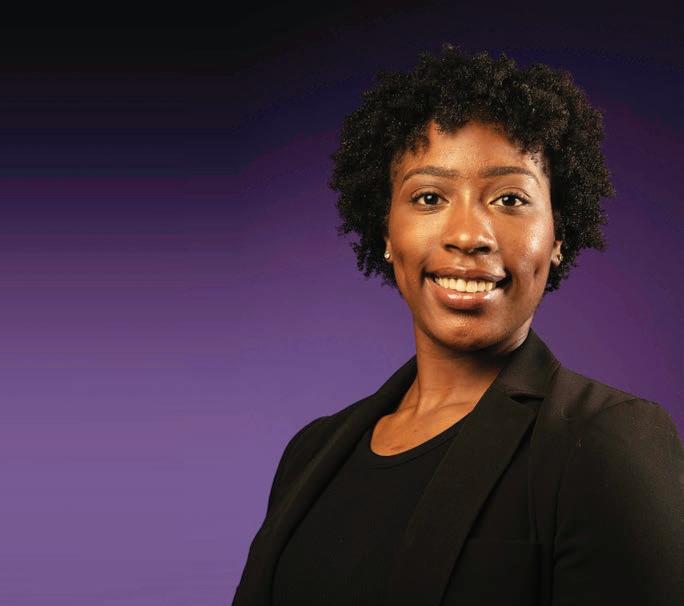
“ Keep it real, have con dence in yourself, and don’t be afraid to do something different and stand out. In order to make a splash, you have to really be secure in yourself.”
HOSPITAL/ ADDRESS
1 NEWYORK-PRESBYTERIAN HOSPITAL 1
525 E. 68th St.
New York,NY10065
2
NYU LANGONE HEALTH 2 550 First Ave.
New York,NY10016
3 MONTEFIORE MEDICAL CENTER
4
111 East 210th St. Bronx,NY10467-2401
LONG ISLAND JEWISH MEDICAL CENTER 3 270-05 76th Ave. New Hyde Park,NY11040
MOUNT SINAI HOSPITAL
5
6
1 Gustave L. Levy Place New York,NY10029
NORTH SHORE UNIVERSITY HOSPITAL 4
300 Community Drive
Manhasset,NY11030
7 CATHOLIC HEALTH 992 N. Village Ave. Rockville Centre,NY11570
8 HACKENSACK MERIDIAN HACKENSACK UNIVERSITY MEDICAL CENTER
30 Prospect Ave. Hackensack,NJ07601
9 STONY BROOK UNIVERSITY HOSPITAL 101 Nicolls Road Stony Brook,NY11794
CENTER 100 Woods Road Valhalla,NY10595
PHONE NUMBER/ WEBSITE/ NETWORK AFFILIATION HOSPITAL LEADER
212-746-5454 nyp.org NewYork–Presbyterian
212-263-7300 nyulangone.org
718-920-4321 monte ore.org Monte ore Health System
516-470-7000 northwell.edu Northwell Health
StevenCorwin, M.D. President, chief executive
RobertGrossman, M.D. Chief executive of NYU Langone Health, dean of NYU Grossman School of Medicine
PhilipOzuah,M.D. President, chief executive
212-241-6500 mountsinaihealth.org Mount Sinai Health System DavidReich, M.D. President
516-562-0100 northwell.edu Northwell Health
JonSendach Executive director
516-705-3700 chsli.org PatrickO'Shaughnessy, D.O. President, chief executive
551-996-2000 hackensackumc.org Hackensack Meridian Health
631-444-4000 stonybrookmedicine.edu Stony Brook Medicine
914-493-7000 WestchesterMedicalCenter.org Westchester Medical Center Health Network (WMCHealth)
LENOX HILL HOSPITAL 100 E. 77th St New York,NY10075 212-434-2000 northwell.edu Northwell Health
MAIMONIDES MEDICAL CENTER 5 4802 Tenth Ave. Brooklyn,NY11219
718-283-3900 maimonidesmed.org
mountsinaihealth.org Mount Sinai Health System
NEWYORK-PRESBYTERIAN QUEENS 56-45 Main St. Flushing,NY11355
718-670-2000 nyp.org/queens NewYork-Presbyterian
KennethGibbs President, chief executive BarryStern President, chief executive, Maimonides Midwood Community Hospital
3,4022,261,7991,052,218
2,0731,835,722540,243
1,5584,124,749492,925
1,600915,713500,211
1,3671,075,254400,148
8591,186,511288,914
1,91868,066430,670
803543,923247,674
822609,604241,809
888339,738275,014
634286,111118,933
DouglasPadgett, M.D.
Surgeon-in-chief, medical director
BryanKelly, M.D. President, chief executive
535384,963156,619
215712,60330,142
912644,688247,106
685706,245203,225
292862,055106,799
HOSPITAL/ ADDRESS
1 NEWYORK-PRESBYTERIAN HOSPITAL 1
20 MOUNT SINAI BETH ISRAEL 7 281 First Ave. New York,NY10003
2
525 E. 68th St.
New York,NY10065
NYU LANGONE HEALTH 2 550 First Ave.
New York,NY10016
PHONE NUMBER/ WEBSITE/ NETWORK AFFILIATION
212-746-5454 nyp.org NewYork–Presbyterian
LEADER
StevenCorwin, M.D. President, chief executive
212-420-2000 mountsinaihealth.org Mount Sinai Health System ElizabethSellman President ScottLorin, M.D. President, Mount Sinai Brooklyn
212-263-7300 nyulangone.org
718-245-3131 nychealthandhospitals.org NYC Health + Hospitals
RobertGrossman, M.D. Chief executive of NYU Langone Health, dean of NYU Grossman School of Medicine
3 MONTEFIORE MEDICAL CENTER
4
111 East 210th St. Bronx,NY10467-2401
ST. FRANCIS HOSPITAL 100 Port Washington Blvd. Roslyn,NY11576
23 COOPERMAN BARNABAS MEDICAL CENTER 8
5
6
LONG ISLAND JEWISH MEDICAL CENTER 3 270-05 76th Ave. New Hyde Park,NY11040
94 Old Short Hills Road Livingston,NJ07039
MOUNT SINAI HOSPITAL
THE VALLEY HOSPITAL 4 Valley Health Plaza Paramus,NJ07652
1 Gustave L. Levy Place New York,NY10029
NORTH SHORE UNIVERSITY HOSPITAL 4
300 Community Drive
SOUTH SHORE UNIVERSITY HOSPITAL
Manhasset,NY11030
301 E. Main St. Bay Shore,NY11706
7 CATHOLIC HEALTH 992 N. Village Ave. Rockville Centre,NY11570
27
BRONXCARE HEALTH SYSTEM 1276 Fulton Ave. Bronx,NY10456
HEALTH + HOSPITALS/ ELMHURST 79-01 Broadway Elmhurst,NY11373
8 HACKENSACK MERIDIAN HACKENSACK UNIVERSITY MEDICAL CENTER 30 Prospect Ave. Hackensack,NJ07601
9 STONY BROOK UNIVERSITY HOSPITAL 101 Nicolls Road Stony Brook,NY11794
MEDICAL CENTER 100 Woods Road Valhalla,NY10595
516-562-6000 stfrancisheartcenter.chsli.org Catholic Health
718-920-4321 monte ore.org Monte ore Health System
516-470-7000 northwell.edu Northwell Health
973-322-5000 rwjbh.org/ coopermanbarnabas RWJBarnabas Health
212-241-6500 mountsinaihealth.org Mount Sinai Health System
201-447-8000 valleyhealth.com Valley Health System
PhilipOzuah,M.D. President, chief executive
RobertBrenner, M.D. President, Valley Health System
AudreyMeyers Chief executive, Valley Health System
516-562-0100 northwell.edu Northwell Health JonSendach Executive director
631-968-3000 northwell.edu Northwell Health
chsli.org
718-901-8600 bronxcare.org BronxCare Health System
551-996-2000 hackensackumc.org Hackensack Meridian Health
718-334-4000 nychealthandhospitals.org NYC Health + Hospitals
631-444-4000 stonybrookmedicine.edu Stony Brook Medicine
914-493-7000 WestchesterMedicalCenter.org Westchester Medical Center Health Network (WMCHealth)
MiguelFuentes President, chief executive
697535,572139,562
3,4022,261,7991,052,218
2,0731,835,722540,243
1,5584,124,749492,925
1,600915,713500,211
1,3671,075,254400,148
8591,186,511288,914
325183,203109,677
1,91868,066430,670
570900,280177,115
803543,923247,674
43720,841120,673
888339,738275,014 11 LENOX HILL HOSPITAL 100 E. 77th St New York,NY10075
MAIMONIDES MEDICAL CENTER 5 4802 Tenth Ave. Brooklyn,NY11219
northwell.edu Northwell Health
718-283-3900 maimonidesmed.org
212-523-4000 mountsinaihealth.org Mount Sinai Health System
NEWYORK-PRESBYTERIAN QUEENS 56-45 Main St. Flushing,NY11355
HEALTH + HOSPITALS/ QUEENS 82-68 164th St. Jamaica,NY11432
718-670-2000 nyp.org/queens NewYork-Presbyterian
212-606-1000 hss.edu
KennethGibbs President, chief executive BarryStern President, chief executive, Maimonides Midwood Community Hospital
634286,111118,933
535384,963156,619
DouglasPadgett, M.D.
Surgeon-in-chief, medical director
BryanKelly, M.D. President, chief executive
269430,03876,920
NewYorkarea includesthe veboroughsofNewYorkCityandNassau,SuffolkandWestchestercountiesinNewYork,andBergen,Essex,HudsonandUnioncountiesinNewJersey. Crain's usesstaff research,extensivesurveysandthemostcurrentreferencesavailabletoproduceitslists,butthereisnoguaranteethattheselistingsarecomplete.Hospitalsarerankedbyunroundedtotaloperating expensesofseparatelyincorporatedfacilities,asidenti edbyMedicarenumber,andmayincludemultiplefacilities.Executivesmayholdadditionaltitles.CARESactfundsarenotincludedin gures, unlessotherwisenoted. 1. Includesthesystem'sCornell,ColumbiaandLowerManhattancampuses,excludingpsychiatricandrehabservices. 2. IncludesallofNYULangoneHealth'shospitalsites. 3. FranklinandForestHillsarecombinedunderLongIslandJewishMedicalCenter. 4. SyossetiscombinedunderNorthShoreUniversityHospital. 5. Figuresre ectcombined guresforMaimonides andMidwoodCommunityHospital. 6. Comprises guresfromMountSinaiMorningsideandMountSinaiWest,whichwerepreviouslyknownasMountSinaiSt.Luke'sandMountSinaiRoosevelt, respectively. 7. IncludesdataforMountSinaiBrooklyn. 8. FormerlySaintBarnabasMedicalCenter. 9. ThroughMarch2024. 10. FormerlySouthNassauCommunitiesHospital. 11. Formerlyknownas NYC Health + Hospitals/Coney Island.
685706,245203,225
Software Engineer (Citadel Enterprise Americas Services LLC – New York, NY); Mult. Pos. Avail. Des, dev, test and deploy next gen software sol for research, trading and bus ops across the firm. F/T. Reqs a Master’s degree (or foreign equiv) in Comp Science, Engineer’g, or a rel field and two yrs of exp with platform and web dev. Must have 2 yrs of exp in each of the following: Programming languages such as C, C++, Python, Java, or JavaScript; Scripting languages incl Shell Scripting (Bash); Working with fin data; and performing data model’g. Sal range $175,000$275,000/yr. Resumes: citadelrecruitment@citadel.com. Ref JobID: 7500823.
Analyst (Citadel Americas Services LLC – New York, NY); Mult pos avail. Anlz fin stmts & bus strategies, build det fin models & cond company DD & channel checks. Prov coverage for co’s in a specific subsector. F/T. Sal range $200,000 –$250,000/yr. Apply w/resume to citadelrecruitment@citadel.com. Ref JobID: 7381568.
Portfolio Risk Manager, Vice President (Pacific Investment Management Company LLC (PIMCO) – New York, NY); Mult. pos. avail. Monit portfolio risk measures and prods across various asset classes to id key risk factors and alpha contributors. Est risk metrics incl duration, convexity, and the Greeks for major positions and implement multi-factor risk model to eval profit and loss (“PnL”) of portfolios. F/T. Sal range $210,000 to $240,000 yr. Apply w/ resume to Lupe.Rubalcaba@pimco.com. Ref. Job ID: 7835350.
Software Engineer (Citadel Securities Americas Services LLC – New York, NY); Mult. pos. avail. Job duties incl: Dsgn. & bld. sftwr. cmpnts. that are fndtnl. to rsrch. & trdng. activities. Enhnc. prprtry. electronic trdng. systms. & tools to support new prdcts. & algrthms. F/T. Sal. range $195,000 – $215,000/yr. Apply w/ resume to citadelrecruitment@citadel.com. Ref Job ID: 8181120.
Zebra Tech Corp has an opning in Holtsville, NY for Sr. Enterprise Systms Anlyst: Spprt & maintn SaaS & entrprs-wide apps. BS+5 yrs reqd. Salary: $110,568-$139,900. Salary offered will vary w/in range based on variety of factors. All Zebra roles eligible for cash incentive programs. Telecom may be prmtd. When not telecom, mst rprt to wrkste. To apply email resume to Jobs@Zebra.com & ref job #7278922. If you are an indvdal w/a disbility & need asstnce in aplyng for psiton, contct us at workplace.accommodations@zebra.com. The EEO is the Law. The posters are avalble here:https://www.eeoc.gov/sites/default/files/2023-06/22088_EEOC_KnowYourRights6.12.pdf; https://www.dol.gov/sites/dolgov/files/ofccp/regs/compliance/posters/pdf/OFCCP_ EEO_Supplement_Final_JRF_QA_508c.pdf
Zebra Tech Corp has an opning in Holtsville, NY for Advncd SW Eng. Anlyzs, dev, dsgns & maintns SW for prdcts & systms. BS+8 or MS+6 yrs exp reqd. Salary: $169,229-$178,600. Salary offered will vary w/in range based on variety of factors. All Zebra roles eligible for cash incentive programs. Telecom may be prmtd. When not telecom, mst rprt to wrkste. To apply email resume to Jobs@Zebra.com & ref job #7322267. If you are an indvdal w/a disbility & need asstnce in aplyng for psiton, contct us at workplace.accommodations@zebra.com. The EEO is the Law. The posters are avalble here:https://www.eeoc.gov/sites/default/files/2023-06/22088_EEOC_KnowYourRights6.12.pdf; https://www.dol.gov/sites/dolgov/files/ofccp/regs/compliance/posters/pdf/ OFCCP_EEO_Supplement_Final_JRF_QA_508c.pdf
Notice of Qualification of 99C CAPITAL PARTNERS LLC Appl. for Auth. filed with Secy. of State of NY (SSNY) on 04/23/24. Office location: NY County. LLC formed in Delaware (DE) on 04/17/24. SSNY designated as agent of LLC upon whom process against it may be served. SSNY shall mail process to c/o Tarter Krinsky & Drogin LLP, Attn: Gina Piazza, 1350 Broadway, 11th Fl., NY, NY 10018. DE addr. of LLC: c/o Corporation Service Co., 251 Little Falls Dr., Wilmington, DE 19808. Cert. of Form. filed with DE Secy. of State, Div. of Corps., John G. Townsend Bldg., 401 Federal St. - Ste. 4, Dover, DE 19901. Purpose: Any lawful activity.
351 W 48 ST LLC. App. for Auth. filed with the SSNY on 05/03/24. Originally filed with the Secretary of State of New Jersey on 03/07/24. Office: New York County. SSNY designated as agent of the LLC upon whom process against it may be served. SSNY shall mail copy of process to the LLC, 161 Western Drive, Short Hills, NJ 07078. Purpose: Any lawful purpose.
Notice of Formation of THEVOZ & PARTNERS, LAW FIRM, PLLC. Arts of Org filed with Secy of State of NY (SSNY) on 11/22/23. Office Location: NY County. SSNY designated as agent upon whom process may be served and shall mail copy of process against PLLC to 1239 Broadway, Ste 1005, New York, NY, US 10001. Purpose: any lawful act.
Notice of Formation of 231 LINNET COURT, LLC Arts. of Org. filed with Secy. of State of NY (SSNY) on 04/23/24. Office location: NY County. SSNY designated as agent of LLC upon whom process against it may be served. SSNY shall mail process to Ani Gabrellian, 450 E. 83rd St., Apt. 20B, NY, NY 10028. Purpose: Any lawful activity.
ELBOW CLUB LLC Arts of Org filed with Secy of State of NY (SSNY) on 2/13/24. Office Location: NY County. SSNY designated as agent upon whom process may be served against LLC to: PO BOX 488, LINCOLN PARK, NJ 07035, USA, Purpose: any lawful act.
Notice of Formation of BEING UNBOUND MENTAL HEALTH COUNSELING PLLC
Arts. of Org. filed with Secy. of State of NY (SSNY) on 02/15/24. Office location: NY County. SSNY designated as agent of LLC upon whom process against it may be served. SSNY shall mail process to; 70 Park Terrace East, Apt 4H, New York, NY 10034.
JOHNORR77@GMAIL.COM
Purpose: Any lawful activity
Notice of Qualification of BIDDEO MEDIA SOLUTIONS LLC Appl. for Auth. filed with Secy. of State of NY (SSNY) on 04/23/24. Office location: NY County. LLC formed in Delaware (DE) on 04/08/24. SSNY designated as agent of LLC upon whom process against it may be served. SSNY shall mail process to c/o Corporation Service Co., 80 State St., Albany, NY 12207-2543. DE addr. of LLC: 251 Little Falls Dr., Wilmington, DE 19808. Cert. of Form. filed with Jeffrey W. Bullock, DE Secy. of State, Div. of Corps., 401 Federal St., Ste. 4, Dover, DE 19901. Purpose: Any lawful activity.
Notice of Formation of FAIRVIEW HOUSING CLASS B, LLC Arts. of Org. filed with Secy. of State of NY (SSNY) on 05/17/24. Office location: NY County. Princ. office of LLC: 30 Hudson Yards, 72nd Fl., NY, NY 10001. SSNY designated as agent of LLC upon whom process against it may be served. SSNY shall mail process to Corporation Service Co., 80 State St., Albany, NY 12207. Purpose: Any lawful activity.
Notice of Formation of RWP Bar and Grill LLC. Arts of Org filed with Sec'y of State of NY (SSNY) on 11/9/23. Office location: NY County. SSNY designated as agent upon whom process may be served and shall mail copy of process against LLC to Rocket Corporate Services Inc., 2804 Gateway Oaks Dr., Ste 100, Sacramento, CA 95833. P/B/A: 330 W 28th St., 18A, NY, NY 10001. Purpose: Any Lawful Act."
Notice of Formation of AG PARATUS LLC Arts. of Org. filed with Secy. of State of NY (SSNY) on 5/16/24. Office location: NY County. SSNY designated as agent of LLC upon whom process against it may be served. SSNY shall mail process to 228 Park Ave South, #196188, NY, NY 10003. Purpose: Any lawful activity
Notice of Qualification of THEOREM PARTNERS LLC Appl. for Auth. filed with Secy. of State of NY (SSNY) on 05/15/24. Office location: NY County. LLC formed in Delaware (DE) on 09/26/13. SSNY designated as agent of LLC upon whom process against it may be served. SSNY shall mail process to Corporation Service Co. (CSC), 80 State St., Albany, NY 12207-2543. DE addr. of LLC: c/o CSC, 251 Little Falls Dr., Wilmington, DE 19808. Cert. of Form. filed with Secy. of State, 820 N. French St., 10th Fl., Wilmington, DE 19801. Purpose: Any lawful activity.
Notice of Qualification of GUILD GARAGE GROUP LLC Appl. for Auth. filed with Secy. of State of NY (SSNY) on 05/15/24. Office location: NY County. LLC formed in Delaware (DE) on 10/11/23. Princ. office of LLC: 55 Hudson Yards, 29th Fl., NY, NY 10001. SSNY designated as agent of LLC upon whom process against it may be served. SSNY shall mail process to Corporation Service Co. (CSC), 80 State St., Albany, NY 12207-2543. DE addr. of LLC: CSC, 251 Little Falls Dr., Wilmington, DE 19808-1674. Cert. of Form. filed with Secy. of State, Dover Office, 401 Federal St., Ste. 3, Dover, DE 19901. Purpose: Any lawful activity.
Notice of Qualification of ALLEN OVERY SHEARMAN
STERLING US LLP Notice of Reg. filed with Secy. of State of NY (SSNY) on 04/01/24. Office location: NY County. LLP formed in Delaware (DE) on 02/22/24. Princ. office of LLP: 599 Lexington Ave., NY, NY 10022-6069. SSNY designated as agent of LLP upon whom process against it may be served. SSNY shall mail process to c/o Corporation Service Co., 80 State St., 10th Fl., Albany, NY 12210. DE addr. of LLP: 251 Little Falls Dr., Wilmington, DE 19808. Stmt. of Qual. filed with DE Secy. of State, John G. Townsend Bldg., P.O. Box 898, Dover, DE 19901. Purpose: Law.
Notice of Qualification of GSO CAPITAL PARTNERS GP L.L.C. Appl. for Auth. filed with Secy. of State of NY (SSNY) on 05/09/24. Office location: NY County. LLC formed in Delaware (DE) on 09/25/15. Princ. office of LLC: 345 Park Ave., 31st Fl., NY, NY 10154. SSNY designated as agent of LLC upon whom process against it may be served. SSNY shall mail process to c/o Corporation Service Co. (CSC), 80 State St., Albany, NY 12207-2543. DE addr. of LLC: CSC, 251 Little Falls Dr., Wilmington, DE 19808. Cert. of Form. filed with Jeffrey W. Bullock, Secy. of State, Div. of Corps., John G. Townsend Bldg., 401 Federal St. - Ste. 4, Dover, DE 19901. Purpose: Any lawful activity
Notice of Qualification of WEALTHCARE CAPITAL MANAGEMENT LLC
Appl. for Auth. filed with Secy. of State of NY (SSNY) on 04/22/24. Office location: NY County. LLC formed in Delaware (DE) on 05/25/00. SSNY designated as agent of LLC upon whom process against it may be served. SSNY shall mail process to Corporation Service Co., 80 State St., Albany, NY 12207-2543. DE addr. of LLC: 108 Lakeland Ave., Dover, DE 19901. Cert. of Form. filed with Secy. of State, John G. Townsend Bldg., 401 Federal St., Ste. 4, Dover, DE 19901. Purpose: Any lawful activity
On June 27, 2023, Gov. Kathy Hochul took the podium to warn New Yorkers that smoke and haze from wild res in Canada would envelop the state and air quality could fall to “hazardous” levels.
“ is could deteriorate very quickly,” she warned.
Another thing that deteriorated very quickly was her support for congestion pricing. Hochul’s decision to suspend the plan indenitely was all the more startling because as recently as May 20 she was extolling its virtues.
“Walk around many major cities and it won’t take long to encounter frustrated drivers caught in tra c jams, cars spewing exhaust on overpacked streets. We determined the average New York City driver spends 102 hours a year stuck in tra c,” she said at the Global Economic Summit in Ireland, according to tweet from Gothamist reporter Jon Campbell. “ at’s four days sitting behind the wheel of a car instead of sitting by your kid’s bedside, reading them a book, sitting around the dinner table or recon-
From Page 1
pause the program.”
e sudden loss of congestion pricing revenue leaves a gaping hole in the MTA’s capital budget to modernize the city’s subway, buses and commuter rail. As recently as May 12, MTA chair and CEO Janno Lieber said there is “no plan B” to fund the critical upgrades without congestion pricing.
Hochul insisted June 5 that she “remains committed to these investments in public transit” and that the state has “set aside funding to backstop the MTA capital plan.”
e governor added that she is “currently exploring other funding sources” for the MTA.
“While our recovery [from the Covid-19 pandemic] has been stronger and swifter than anyone imagined, it is by no means complete, and we cannot a ord to undercut this momentum,” said Hochul. “I won’t allow this delicate recovery to be jeopardized.”
e postponement comes amid concern that congestion
necting with a friend. ere has to be a better way.”
“It took a long time [to get congestion pricing approved] because people feared backlash from drivers set in their way,” she added. “But, much like housing, if we’re serious about making cities more livable, we must get over that.”
Likewise, overcoming congestion pricing foes was on the governor’s mind when she spoke at a press conference on Dec. 5, 2023.
“From time to time leaders are called upon to envision a better future,” she said. “To be bold in the implementation and execution and undaunted by the opposition.”
Congestion pricing was approved by the state Legislature in 2019 after years of battle. ere were some concerns about how supportive Hochul was during the 2022 gubernatorial campaign because she said congestion pricing wouldn’t begin that year. She quickly clari ed her thinking.
“I support congestion pricing 100%,” she said at a Democratic primary debate on June 16, 2022.

“I’m not sure where the allegation came that I don’t.”
By August 2022, Hochul announced that congestion pricing was back on track after a few hiccups with the Biden administration. “ e MTA is the lifeblood. We will be focusing on ways to generate revenues with congestion pricing,” she told e New York Times. In December of that year, she and Mayor Eric Adams co-signed a report, titled “Making New York Work for Everyone;” it said that both leaders “ rmly
support” congestion pricing.
Last June, federal transportation o cials nally signed o on New York’s congestion pricing plan, and Hochul seemed pleased as could be, especially in light of all the sooty air blowing in from the Canadian forest res.
“We are truly the rst generation to feel the real e ects of climate change,” she said. “And we’re also the last generation to do anything meaningful about it.”
Eddie Small contributed reporting.

suburbs surrounding the city.
Roughly 63% of New York voters opposed the tolls, with just 25% in favor, according to an April Siena College poll.
“While our recovery [from the Covid-19 pandemic] has been stronger and swifter than anyone imagined, it is by no means complete, and we cannot afford to undercut this momentum.”
Gov. Kathy Hochul
pricing could be a factor in upcoming competitive city congressional races. Congestion pricing is broadly unpopular with New York voters, particularly in the
One way the governor may seek to recoup the lost toll revenue is with a beefed-up tax on New York City businesses, according to two people with knowledge of the ongoing discussions. e tolling plan would have charged most motorists $15 to enter Manhattan below 60th Street and raised $1 billion annually that the MTA intended to put toward $15 billion in bonds to fund mass transit upgrades.
Multiple elected o cials and transportation and climate advocates condemned the delay.
Assembly member Jo Anne Simon described it and the potential tax increase as “very disturbing and massively unnecessary.”
Riders Alliance Executive Director Betsy Plum said a postponement is “an outrageous betrayal of our trust.” Manhattan State sen. Liz Kruger said putting o the tolling plan is a “terrible, terrible idea.”
Kathryn Wylde, president and CEO of the Partnership for New York City, called the inde nite pause “disappointing.”
“Her reluctance to impose a new toll at this time is understandable,” Wylde said in a statement. “But the toll revenues would amount to only $1 billion a year, which is far less than the $20+ billion cost of lost productivity, overtime and fuel expenses, environmental and health
costs that are the result of excess tra c congestion on the city’s streets and highways.”
Andrew Rein, president of the Citizens Budget Commission, stressed the urgent need for investment in the region’s mass transit.
“Our transit system urgently needs investment to bring it to a state of good repair; we should not be hurtling towards more ‘Summers of Hell,’” he said.
To balance the MTA’s budget last year, the Legislature approved Hochul’s plan to raise the payroll mobility tax on large city businesses served by the MTA’s transit networks. e increase, which is expected to generate more than $1 billion, was limited to the ve boroughs after it faced major pushback from suburban lawmakers.
Amanda
CONTACT THE NEWSROOM editors@crainsnewyork.com www.crainsnewyork.com/staff
ADVERTISING
www.crainsnewyork.com/advertise
Senior vice president of sales Susan Jacobs (312) 649-5492 or susan.jacobs@crain.com
Director











